罗永进
1960 出生于北京
1978-1982 解放军外语学院,文学学士
1982-1984 解放军外语学院电教中心
1985-1986 浙江美术学院油画系进修
1988-1992 广州美术学院,艺术硕士
1993-1997 解放军外语学院电教中心
1998-1999 中央电视台美术星空,摄像师、自由摄影师
2000 中国美术学院上海艺术设计学院,副教授
个 展
2015 黑白灰,莫空间,河南
2013 心迹,全摄影画廊,上海
2011 身外之物,全摄影画廊,上海
身外之物,西安美术学院美术馆,西安
2010 无常·日常,全摄影画廊,上海
困境照进现实,凹凸影像基地,厦门
2009 无常·日常,扉艺廊,广州
罗永进摄影展,东八时区,798 艺术区,北京
2008 装修,罗永进摄影展,张江美术馆,上海
罗永进摄影展,何香凝美术馆,深圳
2007 Moving Closer,曼谷大学画廊,泰国
2006 视角,Allsopp Contemporary,伦敦,英国
罗永进个展,Eidos,Basarno,意大利
形象,Artsea,上海
2005 时代面孔,Sala del Granaio,Grimaldi 基金会,Modica (RG),意大利
2004 罗永进摄影展,艺术学院摄影画廊,中央大学,汉城,韩国
罗永进个展,中国文化年,里尔市中心,法国
罗永进摄影展,La Galerie Phot-oeil,Fabrezan,法国
2003 是梦吗?Tonson 画廊,曼谷,泰国
2002 时代面孔,Photographic Gallery L.Ghirri,Corte Capitaniale,Caltagirone,意大利
1999 静止的进程,东廊,上海
1996 名人名事,中央美术学院画廊东厅,北京
群 展
2014 立面,全摄影画廊,上海
再造奇遇,连州国际摄影节,连州
上海艺术影像展,上海展览中心,上海
戴汉志:5000个名字,尤伦斯当代艺术中心,北京
当真,瑞象馆,上海
天人之际,余德耀美术馆,上海
超过物,莫空间,河南 / 博洛尼亚美术学院,意大利
塔,全摄影画廊,上海
嵩山微观艺术展,梨面沟,河南
2013 视界贵州,夏约宫,巴黎,法国
OCT当代艺术中心藏品展,深圳
上山下乡,中国美术学院上海艺术设计学院展厅,上海
2012 一个世界两个视界,全摄影画廊,上海
Regrouping,Bend In The River,英国
时差,中德当代艺术展,汉诺威,德国
中国建筑摄影,应用艺术博物馆,科隆,德国
上海城市艺术博览会,花园饭店,上海
OFOTO@Commune by the Great Wall,长城脚下的公社,北京
心动上海,沪申画廊,上海
2011 中国当代摄影,TASVEER,班加罗尔/德里/孟买/加尔各答/艾哈迈达巴德,印度
意大利亚力山德里亚双年展,亚力山德里亚,意大利
Photo L.A.,洛杉矶,美国
2010 大象无形,谷仓当代影像馆,兰州
始终是你自己,长城,北京
大树脚,第五期OCAT国际艺术工作室交流展,J&Z画廊,深圳
中国当代摄影展,也趣画廊,台北
三生万物,证大当代艺术陈列馆,上海
一江春水,前波画廊,北京 / The Collection Art and
Archaeology in Lincolnshire,林肯郡,英国
Open Frame - New Landscape Photography from Chian,Yavuz Fube Art,新加坡
环球金融中心影像艺术展,环球金融中心,上海
Preservation by Design,the Meridian International Center,华盛顿,美国
景悟,周围艺术,上海
2009 态度,泄特艺术,郑州
万象,中国美术学院,杭州
建设中——与世博会共生的影像艺术,浦东图书馆,上海
记忆上海,虹庙画廊,上海
Another China,Meta House,金边,柬埔寨
摄影群展,亦安画廊,北京
剧/场——上海都市摄影,刘海粟美术馆,上海
化解危机,石佛公社,郑州
异物,影像北京,北京农业展览馆,北京
相机诱导的画笔,全摄影画廊,上海
2008 Dopo La Sicilia,Galleria Credito Siciliano,意大利
摄影·全摄影,全摄影画廊,北京
上海春季艺术沙龙,世贸商城,上海
派侬来眯看,全摄影画廊,上海
Another China,Kunstverin Tiergarten,Galerie Nord,柏林,德国
Stairway To Heaven: From Chinese Streets to Monuments and Skyscrapers,Bates College
Museum of Art,Lewiston,美国
2007 影子的炼金术,连州摄影节,连州
17e Recontres Photographiques du Pays de Lorient,法国
Cina,Centro Trevi Kuoturzentrum,Bolzano,意大利
La Chine,Saveurs du Divers,Photoquai,L’ Institut Polonais,巴黎,法国
左右视线,广州摄影双年展,广东美术馆,广州
龙的转身,中国广场,纽约,美国
摄影群展, 大山子艺术节,北京
摄影群展,亦安画廊,上海
群展,石佛公社,郑州
黑白山西,中空间艺术,洛阳
城纪,全摄影画廊,上海
拉市海年度实验艺术展,拉市海海东艺术中心,丽江
2006 显隐——中国摄影二十年,四方当代美术馆,南京
索菲特2006当代艺术展,东尚画廊,西安
过去和将来之间,Museum für Ostasiatische Kunst,德国
过去和将来之间,Haus der Kulturen der Welt,柏林,德国
过去和将来之间,Santa Barbara 美术馆,加利福尼亚,美国
群展,Chinese Eyes画廊,巴黎,法国
2005 过去和将来之间,V&A Museum,英国
过去和将来之间,Seattle 美术馆,美国
河南摄影50年,河南博物院,郑州
都市——重视,广州国际摄影双年展,广东美术馆,广州
回到未来,Kunsthalle Faust,汉诺威,德国
回到未来,Inner Space,波兹南,波兰
都是我,Galleria Caria Soggani,米兰,意大利
天安门,阿姆斯特丹博物馆,丹麦
日常外,多伦美术馆,上海
变术,中空间艺术,洛阳
Exhilaration,亦安画廊,上海
第二现实:中国摄影,European Commission,布鲁赛尔,比利时
丰,艺术景画廊,上海
连州国际摄影年展,连州
2004 亚洲摄影双年展,Kim Young Seob 摄影画廊,汉城,韩国
龙族之梦,中国当代艺术展,爱尔兰当代美术馆,爱尔兰
非正常透视摄影联展,798 时态空间,北京
风景,沪申画廊,外滩三号,上海
2004 VASL艺术展,卡拉奇,巴基斯坦
都是我,北京东京艺术工程,北京
幻觉,亦安画廊,上海
纪录中国,贝兹大学美术馆,路易斯安那州,美国
纪录中国,美国中国学会,纽约,美国
现代上海,Museum Villa Stuck,慕尼黑,德国
过去和将来之间,国际摄影中心,纽约,美国
过去和将来之间,Smart 艺术博物馆,美国
过去和将来之间,芝加哥大学当代美术馆,美国
宋朝、罗永进摄影展,娜娜画廊,书城,普罗旺斯,法国
没有人是傻子也没有人伤害了谁,亦安画廊,上海
上海春季艺术沙龙,上海国际展览中心,上海
2003 Take A Seat,Artsea,上海
都是我,平遥国际摄影节,平遥
新山水,亦安画廊,上海
国际艺术活动展,Silpakorn 大学,曼谷,泰国
2002 长城——百风琴,Palazzone,S. Alberto di Romagan,意大利
隐藏部分,亦安画廊,上海
上海双年展,上海美术馆
平遥国际摄影节,平遥
莫斯科摄影节,Moscow House of Photography,莫斯科
2001 非常聚焦,意大利使馆文化处,北京
Grosse Kunstaustellung NRW,杜赛尔多夫,德国
16届亚洲国际艺术展,广州美术馆,广州
成都双年展,成都现代美术馆,成都
P*摄影展,中国美术学院上海艺术设计学院展厅,上海
It’s Me,东大名创库,上海
中国城市规划展,成都现代美术馆,成都
变形的城市,一品国际摄影节,东营
Strategies against Architecture,Stabilimento Teseco,比萨,意大利
煲,中国当代艺术展,奥斯陆,挪威
2000 大集体,当代文化艺术馆,米兰
陌生的会面,花中城,洛阳
1999 爱,中国当代摄影和摄像,99立川国际艺术节,日本
1998 Anguillara ad Arte,Anguillara Sabazia,罗马,意大利
1997 面对面 ,国际艺苑美术馆,北京
收 藏
纽约国际摄影中心
Bates大学美术馆,缅因
何香凝美术馆
上海张江当代艺术馆
满堂红,广州
上海美术馆
米兰当代文化艺术馆
深圳OCT当代艺术中心
余德耀美术馆, 上海
影藏,上海
Luo Yongjin
1960 Born in Beijing
1978-1982 BA, English Language, PLA University of Foreign Languages, Henan, China
1982-1984 Lecturer, The Audio and Video Centre of the PLA University of Foreign Languages, Henan, China
1985-1986 Department of Oil Painting, China Academy of Fine Arts, Hangzhou, China
1988-1992 MA, History of Art, Guangzhou Academy of Fine Arts, China
1993-1997 Worked at the Audio and Video Centre of the PLA University of Foreign Languages, Luoyang, Henan
1998-1999 Freelancing Photographer, and Cameraman, China Central TV, Beijing
2000 Professor of Photography, Shanghai Institute of Design of China Academy of Fine Arts, Shanghai
SOLO EXHIBITIONS
2015 Black, White, Grey, Mo Art Space, Henan
2013 Heart Steps, OFOTO Gallery, Shanghai
To the Countryside, Gallery of Shanghai Institute of Design, China Academy of Art
2011 Artists’ Belongings, OFOTO Gallery, Shanghai
Artists’ Belongings, Art Museum of Xian Art Academy, Xi’an
2010 Extraordinary·Ordinary, OFOTO Gallery, Shanghai
Plight Shines into the Realiy, Auto Art Center, Xiamen
2009 Extraordinary·Ordinary, Fei Gallery, Guangzhou
Luo Yongjin Photography Exhibition, Timezone 8 Bookstore, 798 Art District, Beijing
2008 Renovation, Zhangjiang Contemporary Art Museum, Shanghai
Luo Yongjin Photography Exhibition, Hexiangning Art Museum, Shenzhen
2007 Moving Closer, Bangkok University Gallery, Bangkok, Thailand
2006 View Points, Allsopp Contemporary, London, UK
Luo Yongjin Photography Exhibition, Eidos, Barsano, Italy
About Face, Artsea, Shanghai
2005 Faces In Time, Sala del Granaio, Grimaldi Foundation, Modica (RG), Italy
2004 Luo Yongjin Photography Exhibition, Photography Gallery of Art College, Seoul, Korea
Luo Yongjin Solo Exhibition, Year of Chinese Culture, Central Lille, France
Luo Yongjin Photography Exhibition, La Galerie Photoeil, Fabrezan, France
2003 Are We Dreaming? Tonson Gallery, Bangkok, Thailand
2002 Faces In Time, Photographic Gallery L. Ghirri, Corte Capitaniale, Caltagirone, Italy
1999 Fixed Transience, Eastlink Gallery, Shanghai
1996 Celebrations and Celebrities, CIFA Gallery, Beijing
GROUP EXHIBITIONS
2014 Facade, OFOTO Gallery, Shanghai
Staging Encounters, Lianzhou Foto Festival, Lianzhou
Photo Shanghai, Shanghai Exhibition Center, Shanghai
Hans van Dijk: 5000 Names, UCCA, Beijing
REAL-LY, Ray Art Center, Shanghai
Myth/History, Yuz Collection of Contemporary Art, Shanghai
Oltre La Materia, Mo Space, Henan / Accademia di belle arti di Bologna, Italy
Pagoda, OFOTO Gallery, Shanghai
Songshan Microcosmic Art Exhibition, Limiangou, Henan
2013 Regards sur le Guizhou, Chaillot Palace, Paris, France
Collection from OCAT, OCT Contemporary Art Terminal, Shenzheng
China Academy of Art, Shanghai
2012 A Vision with Two Eyes, OFOTO Gallery, Shanghai
Regrouping, Bend In The River, UK
Jetlag, China-Germany Multimedia Contemporary Art Exhibition, Hannover, Germany
Photogaphy of Architecture Made in China, Museum for Applied Arts, Cologne, Germany
Citizen Art Shanghai, Garden Hotel, Shanghai
OFOTO@Commune by the Great Wall, Commune by the Great Wall, Beijing
Heartbeat Shanghai, Shanghai Gallery of Art, Shanghai
2011 Contemporary Photography in China, TASVEER, (Bangalore, Delhi, Mumbai, Kolkata, Ahmedebad), India
Biennale of Alessandria 2011, Alessandria, Italy
Photo L.A., Los Angeles, USA
2010 Da Xiang Wu Xing, Gucang Contemporary Photo Gallery, Lanzhou
Stay You, the Great Wall, Beijing
Big Tree Foot,The 5th OCAT International Art Residency Exhibition, J&Z Gallery, Shenzhen
Contemporary Photography Exhibition from China, AKI Gallery, Taipei
San Sheng Wan Wu, Zendai Contemporary Art Exhibition Hall, Shanghai
River Flows East-Landscapes of the Imagination, Chambers Fine Art, Beijing / The Collection Art and
Archaeology in Lincolnshire, UK
Open Frame - New Landscape Photography from China, Yavuz Fine Art, Singapore
Global Financial Center Photography Exhibition, Global Financial Center, Shanghai
Preservation by Design, the Meridian International Center, Washington, USA
Landscape Insight, Around Gallery, Shanghai
2009 Attitude, Shit Art, Zhengzhou
All Manifestations of Nature, China Academy of Fine Arts, Hangzhou
Underconstruction-Photography on the Expo 2010 Shanghai, Pudong Library, Shanghai
Memory of Shanghai, Hongmiao Gallery, Shanghai
Another China, Meta House, Phnom Penh, Cambodia
Group Photography Exhibition, Aura Gallery, Beijing
Drama/Stage: Urban Photography in Shanghai, Liu Haisu Art Museum, Shanghai
Resolving The Crises, Shifo Commune, Zhengzhou
Otherness, Photo Beijing, The Agricultural Exhibition Centre of China, Beijing
The Photograph’s Enticement of the Brush, OFOTO Gallery, Shanghai
2008 Dopo La Sicilia, Galleria Credito Siciliano, Italy
FOTO·OFOTO, OFOTO Gallery, Beijing
Art Shanghai 2008, Shanghai Mart, Shanghai
Panoramic, OFOTO Gallery, Shanghai
Another China, Kunstverin Tiergarten, Galerie Nord, Berlin, Germany
Stairway To Heaven: From Chinese Streets to Monuments and Skyscrapers, Bates College Museum
of Art, Bates College Museum of Art, Lewiston,USA
2007 The Alchemy of Shadows, Lianzhou International Photo Festival, Lianzhou
17e Recontres Photographiques du Pays de Lorient, France
Cina, Centro Trevi Kuoturzentrum, Bolzano, Italy
La Chine, Saveurs Du Divers, Photoquai, L’Institut Polonais, Paris, France
Evolution, 2007 Guangzhou Photo Biennial, Guangdong Museum of Art, Guangzhou
Change of Dragon, China Square, New York, USA
Group Exhibition, 798 Art Festival, Beijing
Group Exhibition, Aura Gallery, Shanghai
Group Exhibition, Eastlink, Shanghai
Group Exhibition, Shifo Commune, Zhengzhou
Shanxi in Black and White, The Heart of the Art Space, Luoyang
One Year of Experimental Art at Lashihai, Lashihai Haidong Art Center, Lijiang
City Tale, OFOTO Gallery, Shanghai
2006 Visible and Invisible-20 Years of Chinese Photography, Sifang Museum of Contemporary Art, Nanjing
Contemporary Chinese Art, Dongshang Gallery, Xi’an
Between Past and Future, New Photography and Video from China, Museum fur Ostasiatische Kunst,
Berlin, Germany
Between Past and Future, New Photography and Video from China, Haus der Kulturender Welt, Berlin,
Germany
Between Past and Future, New Photography and Video from China, Santa Barbara Museum of Art,
CA.Santa Barbara, USA
Group Exhibition, Gallery Chinese Eyes, Paris, France
2005 Group Photography Exhibition, Foam Museum of Photography, Amsterdam, Holland
Between Past and Future, New Photography and Video from China, V&A Museum, UK
Between Past and Future, Seattle Art Museum, USA
50 Years of Henan Photography, Henan Museum, Zhengzhou
Back to Future, Kunsthalle Faust, Hannover, Germany
Back to Future, Inner Space, Poznan, Poland
Guangzhou Photography Biennale, Guangdong Art Museum, Guangzhou
It Is I, Galleria Caria Sozzani, Milano, Italy
Beyond The Everyday, Doland Museum of Art, Shanghai
Change, The Heart of the Art, Luoyang
Tiananmen, Photograph Museum in Amsterdam, Holland
Exhilaration, Aura Gallery, Shanghai
The Second Reality: Photographs from China, European Commission, Brussels, Belgium
Harvest, Art Scene Warehouse, Shanghai
Lianshou International Photography Festival, Lianzhou
2004 Asia Photography Biennale, Kim Young Seob Photo Gallery, Seoul, Korea
Dreaming of the Dragon’s Nation, Irish Museum of Modern Art, Dublin, Ireland
Un-normal Perspective, 798 Space, Beijing
Land-scapes, Shanghai Gallery of Art, Three on the Bund, Shanghai
2004 VASL Exhibition, VM Art Gallery, Karachi, Pakistan
It Is I, Beijing Tokyo Art Projects, Beijing
Illusion, Aura Gallery, Shanghai
Documenting China, Bates College Museum of Art, Lewiston,USA
Documenting China, China Institute, New York, USA
Shanghai Modern, Museum Villa Stuck, Munchen, Germany
Between Past and Future, The International Center of Photography, New York, USA
Between Past and Future, Smart Museum of Art, Chicago, USA
Between Past and Future, University of Chicago Museum of Contemporary Art, USA
L’annee de la Chine, Cite du Livre, Aix En Provence, France
Nobodys Fool Nobodys Hurt, Aura Gallery, Shanghai
Art Shanghai 2004, INTEX Shanghai, Shanghai
2003 Take A Seat, Artsea, Shanghai
It Is I, Pingyao International Photography Festival, Pingyao
New Chinese Landscape, Aura Gallery, Shanghai
The Overseas International Art Project, Silpakorn University, Bangkok, Thailand
2002 100 Harps for the Great Wall, Palazzone, S. Alberto di Romagan, Italy
The Hidden Part, Aura Gallery, Shanghai
Shanghai Biennale, Shanghai
Pingyao International Photography Festival, Pingyao
Moscow Photography Festival, Moscow House of Photography, Moscow, Russia
2001 Seen From Afar, Italian Cultural Institute, Beijing
Grosse Kunstaustellung Nrw, Duesseldorf, Germany
16th Asian International Art Exhibition, Guangdong Art Museum, Guangzhou
Chengdu Biennale, Chengdu Modern Art Museum, Chengdu
P*Photoshow, Shanghai Design Institute (China Academy of Fine Arts, Shanghai Branch), Shanghai
It’s Me, DDM Warehouse, Shanghai
Chinese Cities Planning Exhibition, Chengdu Modern Art Museum, Chengdu
The Anamorphic City, Yipin International Photography Festival, Dongying
Strategies Against Architecture II, Stabilimento Teseco, Pisa, Italy
Hotpot, Contemporary Chinese Art, Oslo, Norway
2000 Lost Identities, Contemporanea Arti e Culture, Milan, Italy
Meeting With Strangers, Flower City, Luoyang
1999 Love, Chinese Contemporary Photography & Video, International Arts Festival Tachikawa 99, Japan
1998 Anguillara Ad Arte, Anguillara Sabazia, Rome, Italy
1997 Face to Face, Gallery of the International Art Palace, Beijing
COLLECTIONS
ICP (International Center of Photography)
Bates College Museum of ART (Maine USA)
He Xiangning Art Museum
Shanghai Zhangjiang Museum of Modern Art
Mytophome, Guangzhou
Shanghai Art Museum
Contemporanea Arti e Culture, Milan
OCT Contemporary Art Center, Shenzhen
Yudeyao Art Museum
Photo Take, Shanghai

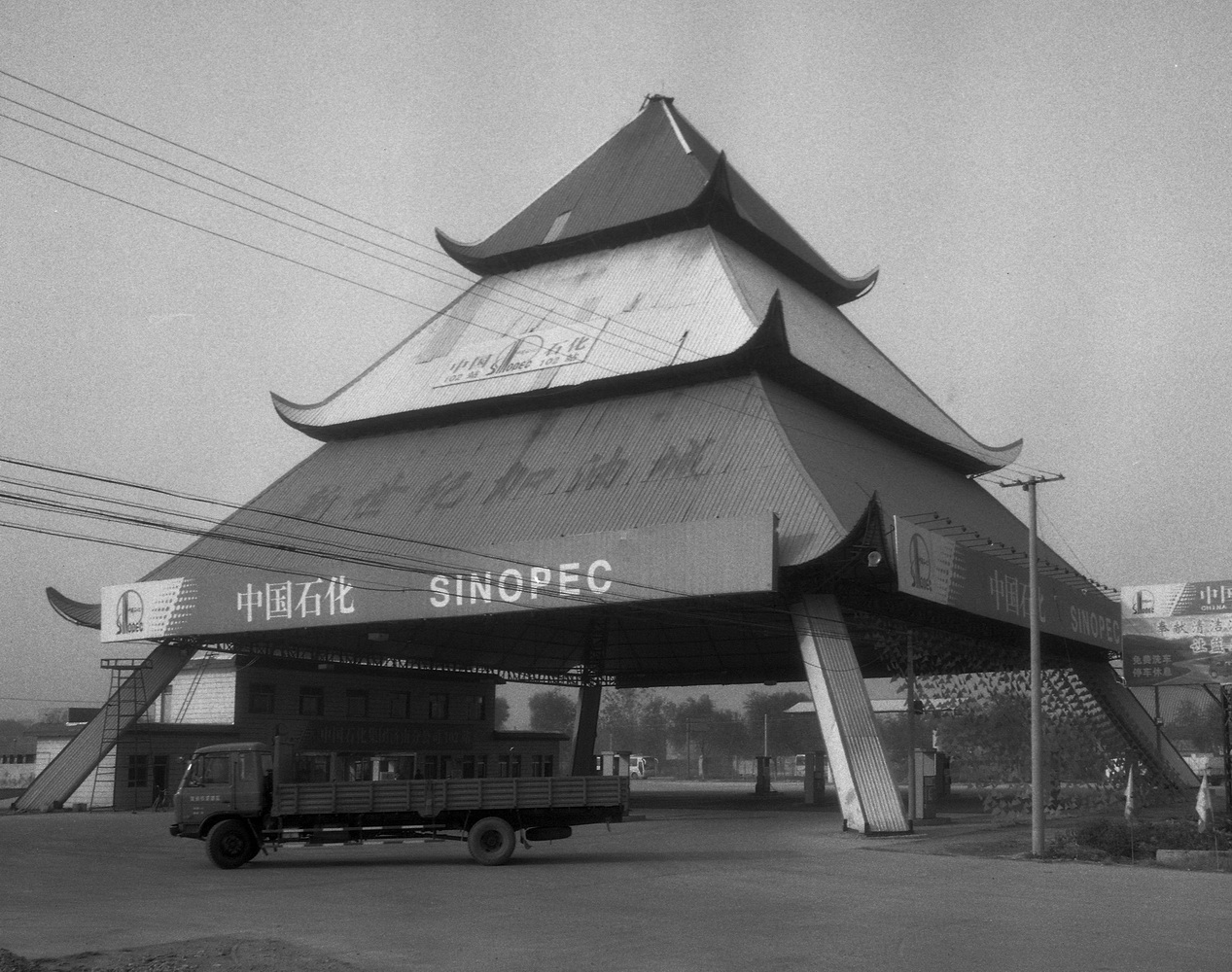
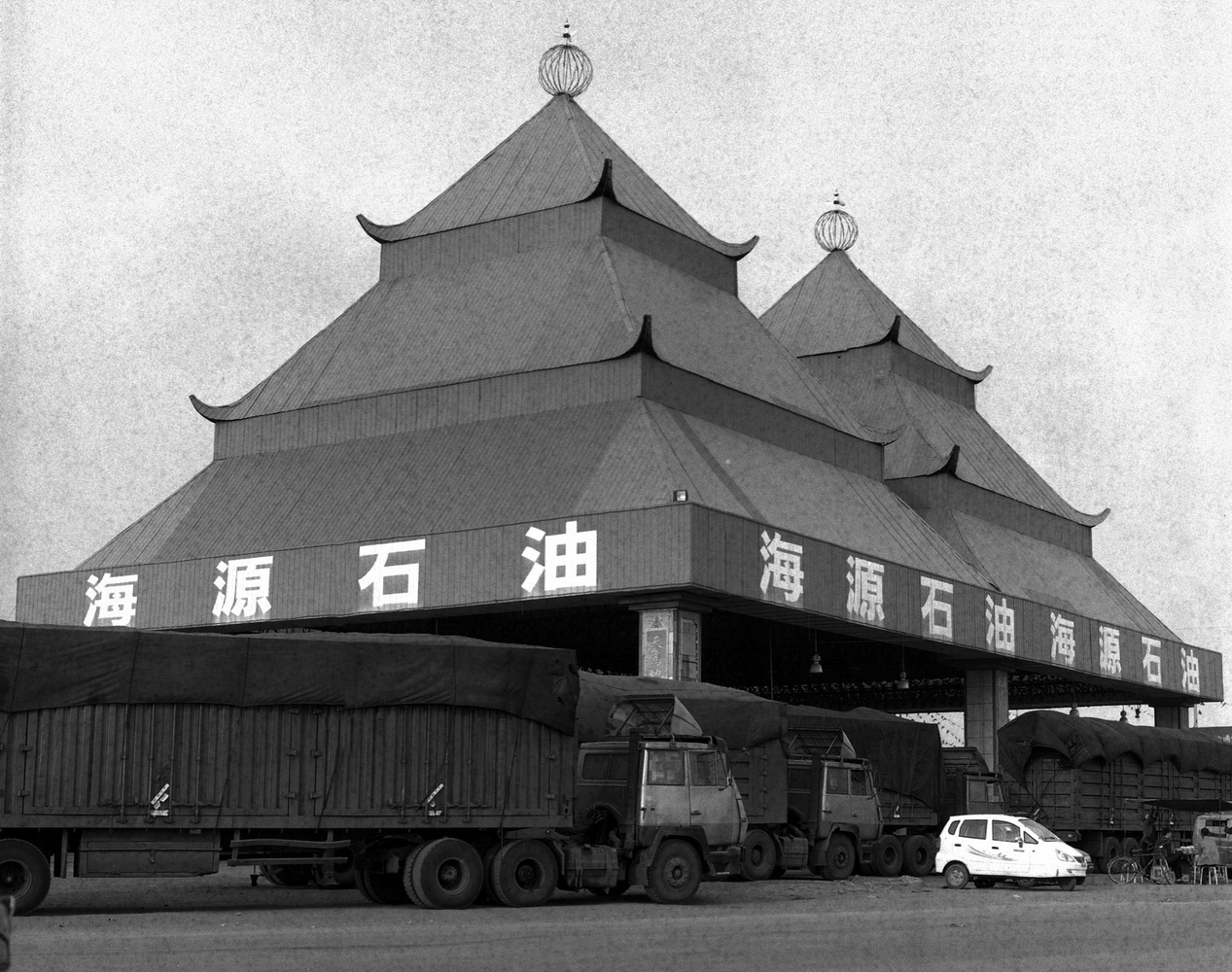
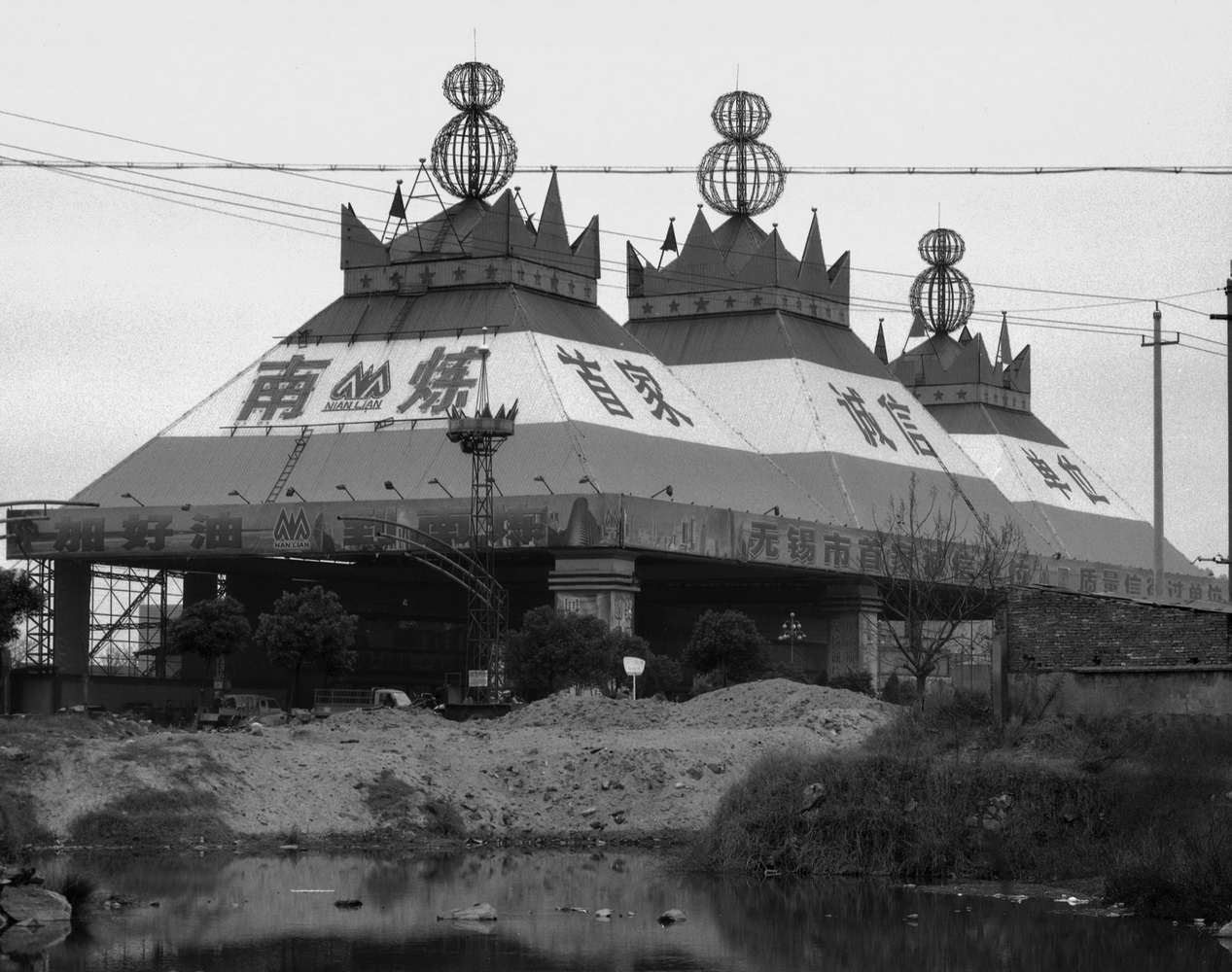
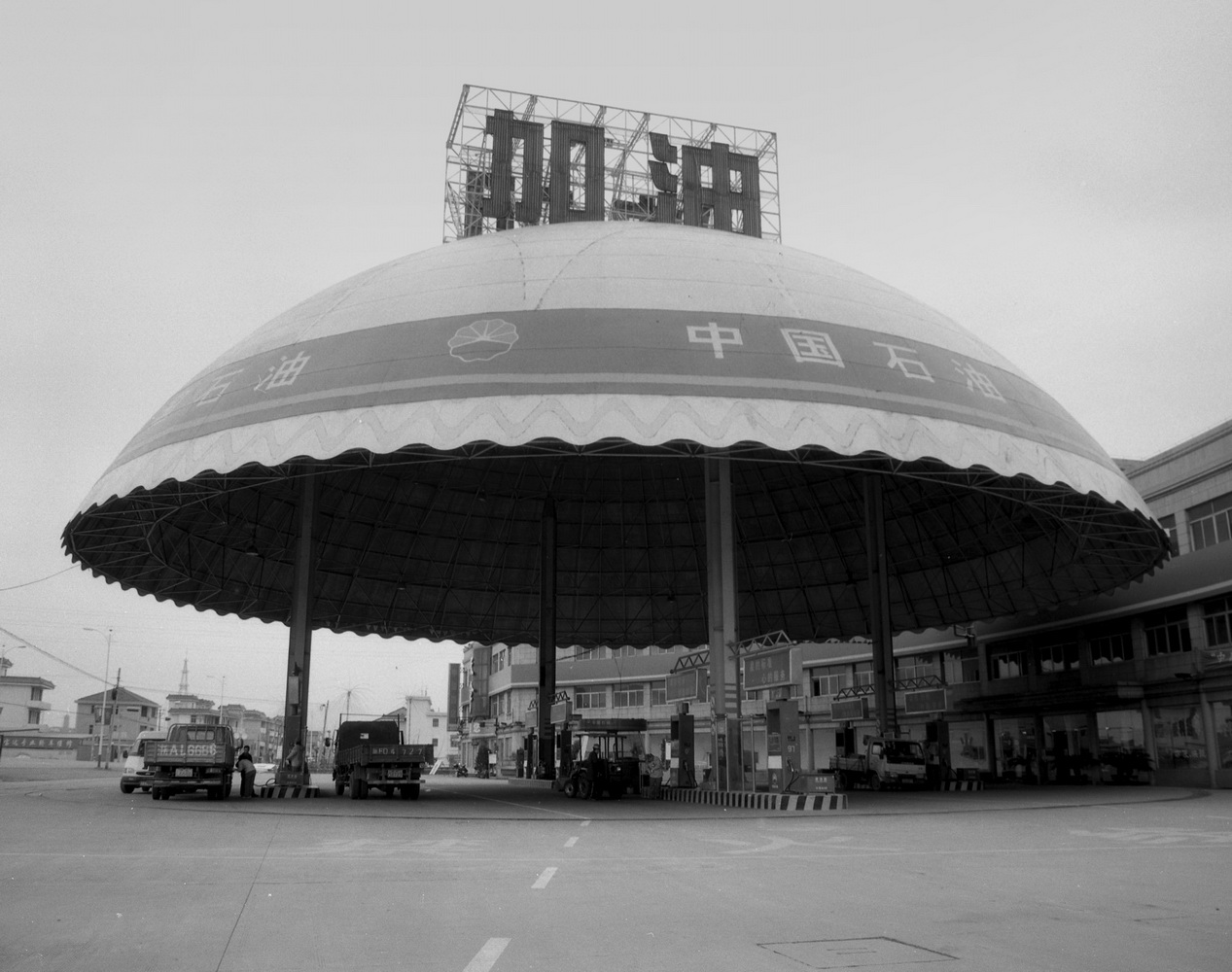
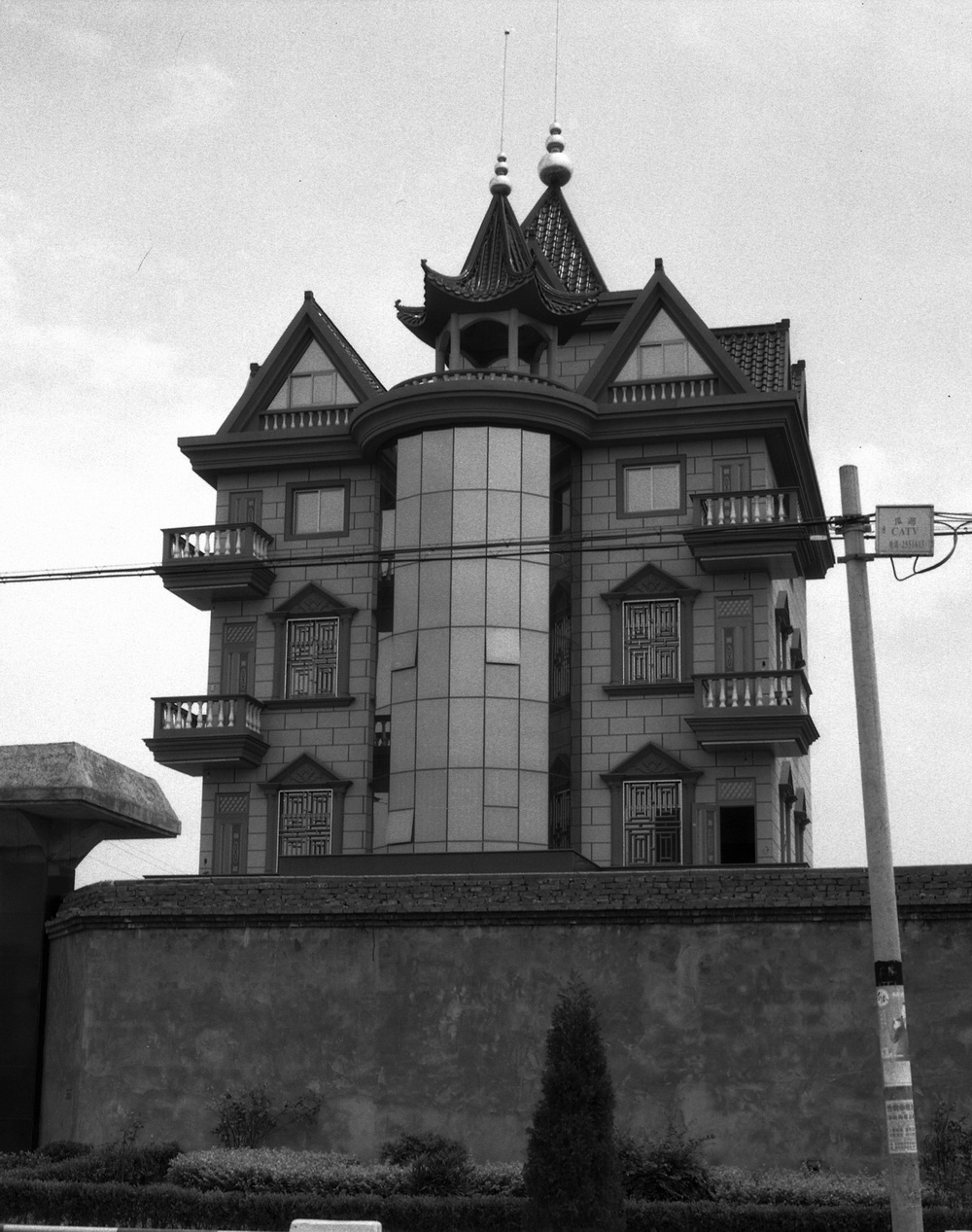
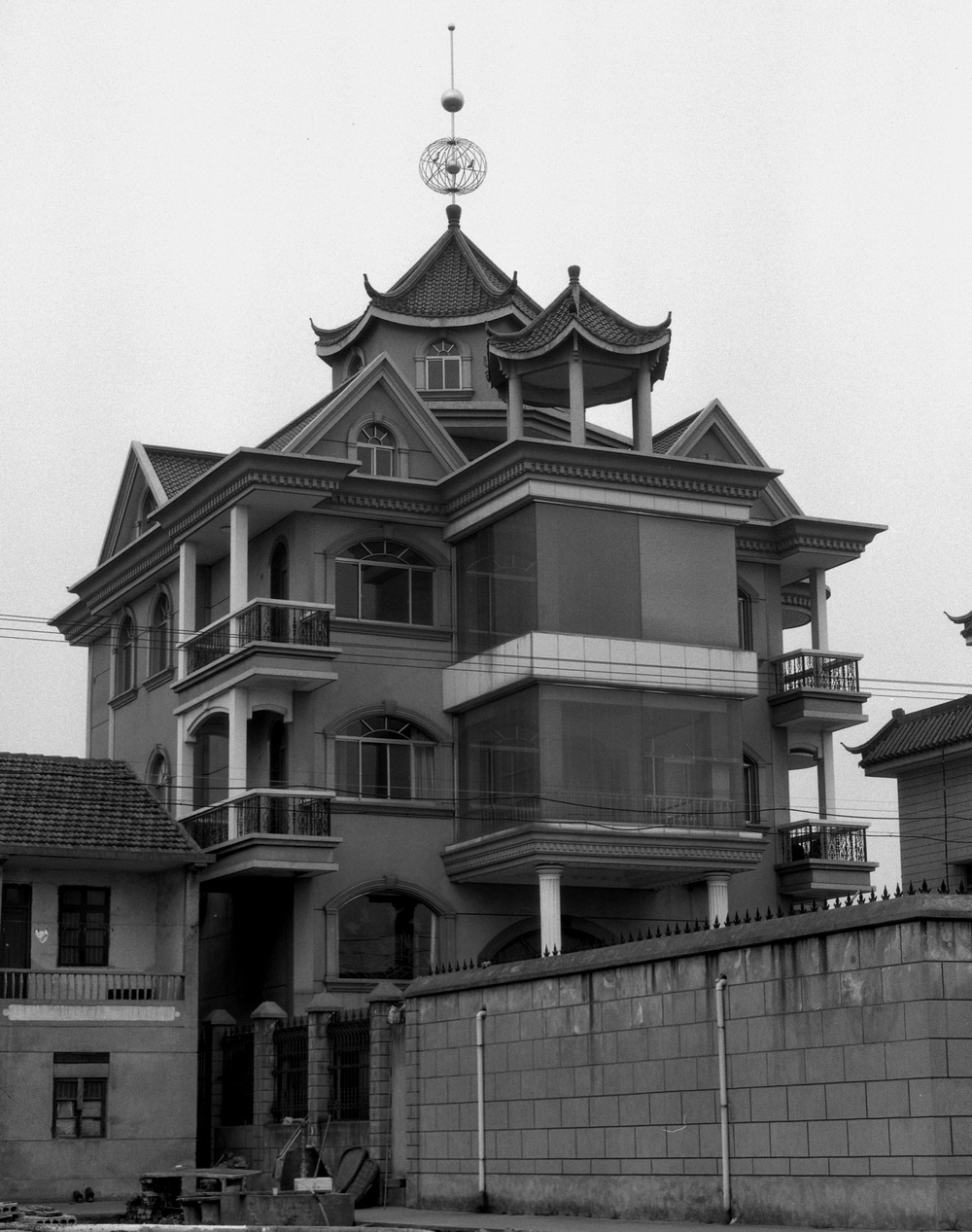
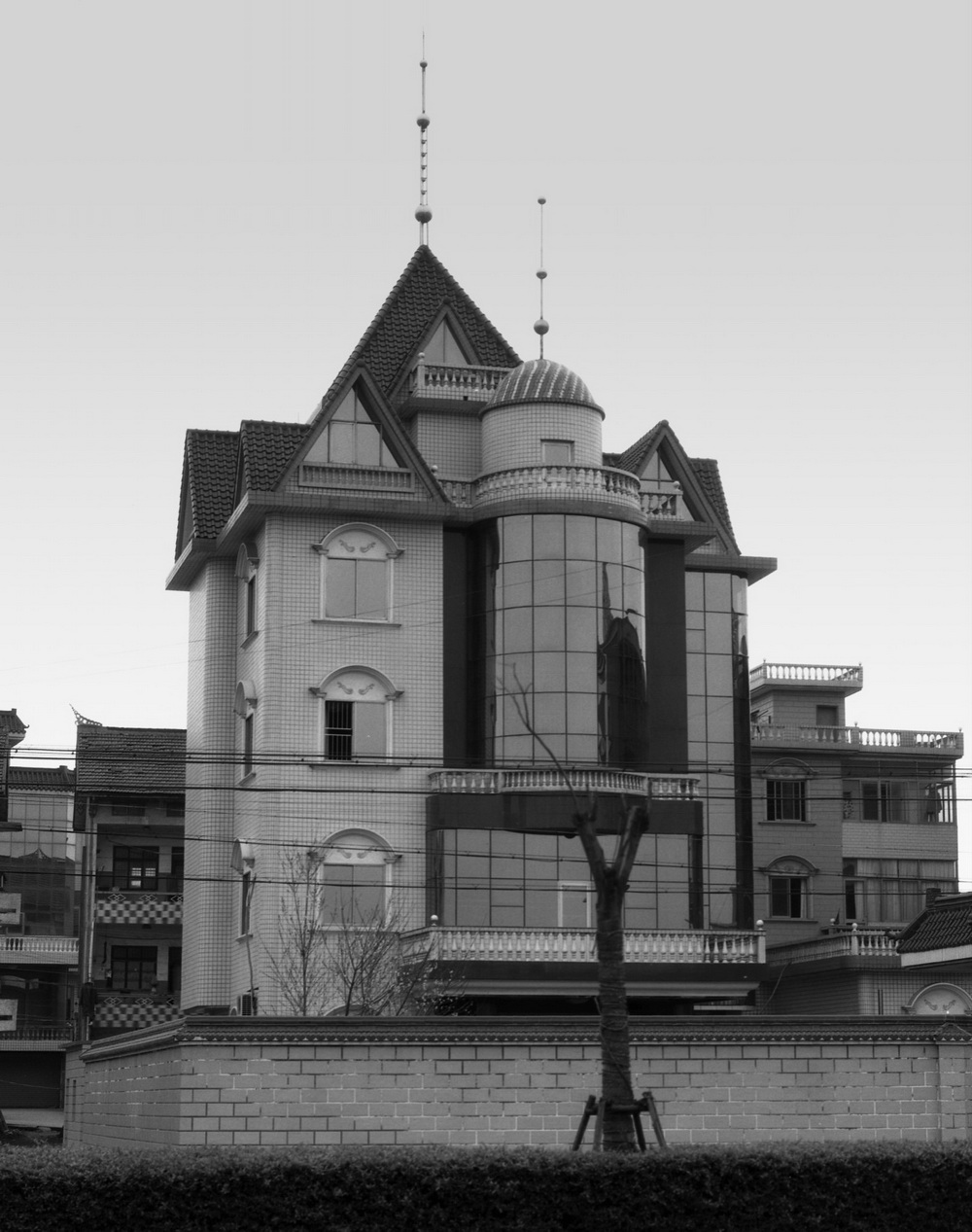
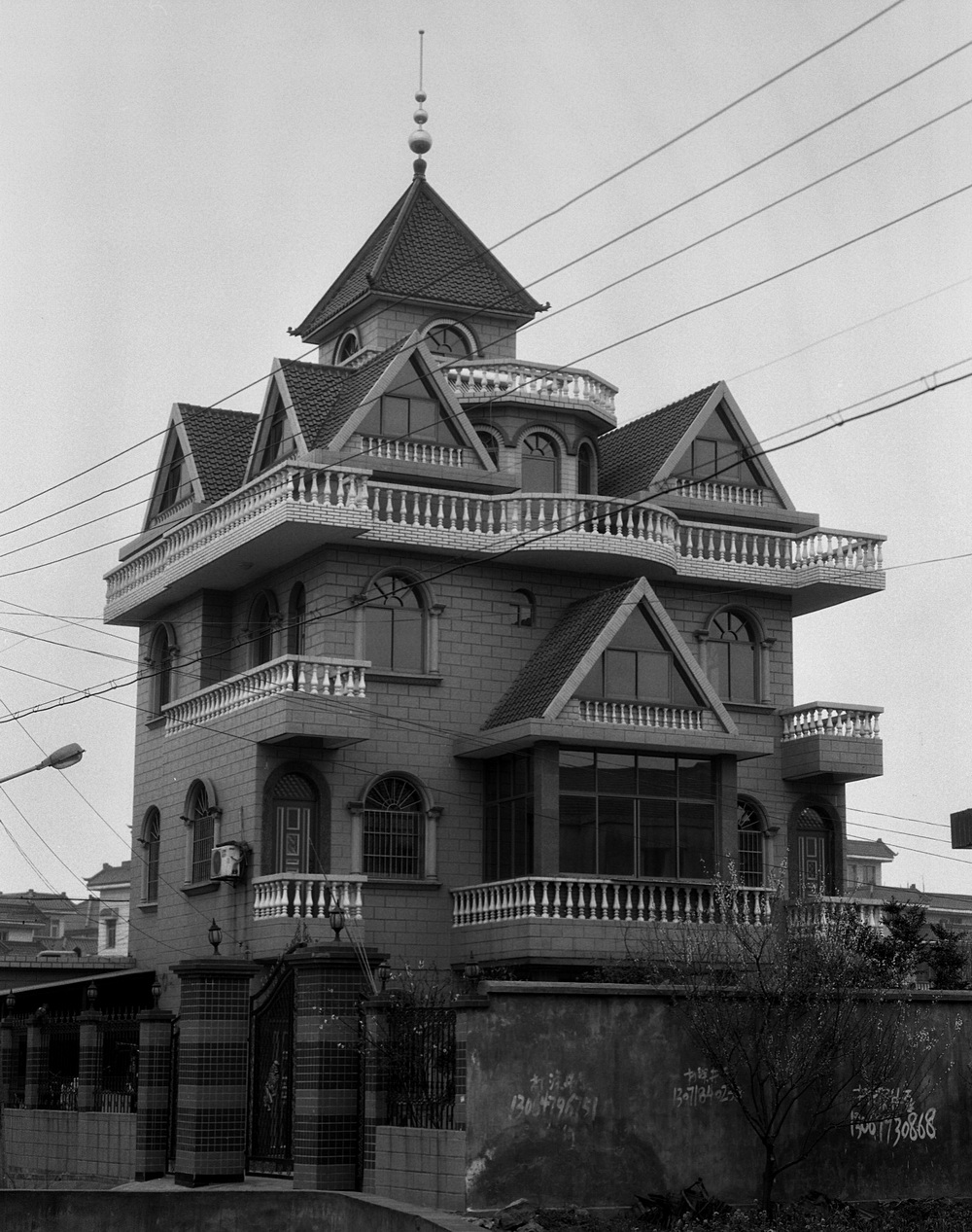

建筑不仅成为了现代城市社会的主要景观,也是社会生产力与物质形态的最具体的呈现。建筑同时也是居住于其中的人们的美学趣味的外化与固化。居住工作于上海的罗永进,于1990年代中期开始了一个至今仍在进行之中的摄影系列-《新民居》。罗永进的《新民居》系列可以分为两个部分:《新民居.洛阳》与《新民居.杭州》。《洛阳》系列拍摄于前,《杭州》系列拍摄于后。
他的《新民居.洛阳》系列虽然拍摄自一个曾经是十三朝古都的并非典型意义上的现代都市洛阳,但在他的图像中所表现出来“前现代”的都市建筑形态,在将中国内地的当代民居以一种非常坚实有力的视觉造型与丰富的视觉肌理加以呈现的同时,也透露了中国人意识深层的建筑美学意识、空间意识与现实生活的品质。
经过罗永进的强烈而又简洁的视觉概括,这些民居令人不可思议地产生一种集中营的错觉。与此同时,他的这些洛阳新民居照片中的建筑造型,居然还会让人联想到西方现代主义建筑的简约风格。不过这种民居建筑风格与西方现代主义建筑的简约风格相比,显得粗鲁而又有勇无谋,但又是的确在视觉上有种不谋而合的巧合。不管这种建筑营造方式的实际动机如何,如果说那是一种不自觉的“现代主义”的话,那么它们只能是一种最不幸的“现代主义”建筑,因为它们不是“居住的机器”,而是居住集中营。
与沿海发达城市的那些林立的摩天高楼形象相比,罗永进的这些面目狰狞的民居建筑形象,透露出中国内陆城市与沿海城市发展程度的巨大落差。这样的建筑图像不仅仅展示了内地居民对于物质生活的要求与标准,也展示了地区间经济文化上的深层意义上的不同。他的这些建筑类型学影像,为了解中国内陆城市中城市与建筑的关系、人与建筑的关系、内地城市与沿海城市的差异等问题提供了一个非常有意义的视觉参照。
从2002年起,罗永进将他的视线转向了浙江杭州附近的私人住宅。这是一种完全不同于洛阳“新”民居的“新”民居。这些住宅都是由中国最早富裕起来的地区之一的居民们按照自己的美学趣味所建造的。如果说洛阳的民居是自发盲目的“现代主义”建筑的话,那么这些杭州的民居则可称为自发盲目的新巴洛克式城堡建筑。与洛阳的那些建筑的粗陋相比,浙江的这些建筑似乎努力在向精致靠拢,并且有一种抑制不住的显示欲想通过建筑的细节装饰顽强地表现出来。这些建筑的特点是拼贴,好像什么“风格”都有那么一点,但又什么也都不是。从照片看,洛阳、杭州这两个不同地方的这两类建筑如果按照一般的审美标准来看,也许根本无从比照。一个是努力以最简单的方式来获得与控制空间的意识的产物,而另一个是展示了一种什么都想要糅合进去的贪婪心理的产物。然而。这两者在骨子里相同的地方是,不可救药的贪婪与不可救药的粗陋。
罗永进的摄影在有力之处在于,他在这将两种截然不同的建筑影像作了一个类型学的归类之后,向我们清晰地呈示了它们在根本上相同的东西。他以格式化的相同的画面形式来安置这两类有着不同“风格”的建筑,并让我们在“风格”的“不同”中发现深层意识上的“同”。一种民族文化心理上的根子里的“同”。一种无从自我节制的疯狂与不可理喻的非理性的“同”。而这也许就是透过建筑流露出来的深藏于民族心理底层的深层无意识。更可悲的是,杭州新民居这类建筑,现在不仅仅只是一些人的美学趣味的现实化,它们其实已经逐渐地成为了一种主导性的趣味,四散蔓延开去,并且开始影响、左右今后的中国民居建筑实践。
稍后,罗永进的《新衙门》系列,则把视线投向那些各级地方政府的行政机构建筑。他以正面取向的视角、中规中矩的画面,努力排除变形与夸张,如实刻划出这些作为权力象征的建筑的夸张造型所体现出的盲目自大与权力的展示欲。他让夸张的建筑本身来展示其荒诞不经。而趣味奇异的行政办公楼建筑所呈现的权力的横暴的存在感,显示出建筑主人的拒人于千里之外的冷漠、蛮横以及对于西方的莫名向往与愚蠢模仿。透过这样的画面,我们不得不承认,建筑的外表确实并不仅仅只是外表,从建筑的外表,的确可以看到建筑的使用者、规划者的内在心理。这样的建筑,经过罗永进的摄影观看,启示我们看到了借建筑所泄漏的有关权力的许多本质性的东西。当人们看到那个上海的区法院竟然以美国的国会建筑为原型而仿造,在不禁哑然失笑之余,还会不会有更多的联想?最近更有新闻传出,安徽阜阳的当地政府,又以上海的这个法院为模型,复制了一个安徽版本的“国会式”建筑。我们感谢罗永进的工作,因为这些仿国会山的建筑如果因为什么原因而被销毁,但罗永进却已经为我们保留了它们的身影。
罗永进投向中国当代建筑的视线,后来又延伸到了广东开平的碉楼建筑。风格怪异的碉楼,是在海外谋生的华侨“成功”后在故乡建造的洋楼。这类建筑,有炫耀财富的心理在,但客观上也引进了某种西方建筑的概念,包括现代生活的卫生标准等,因此也部分实现了某种程度的中西文化交流。它们杂糅了本土与外洋的各种要素,生产出更复杂的造型,也是一种文化杂交的范例。此外,它们当然也是海外华侨在外一生辛苦的人生纪念碑。包括了这么多复杂因素的建筑,对于了解现代中国与世界的关系,是一种不可多得的素材。而这批风格奇特的建筑,如果与时隔近百年后在杭州出现的民居“巴洛克城堡”并列一起,则会令人产生更丰富的联想。
更有意思的是,在罗永进的冷静的观看下,这些看上去像玩具模型似的建筑甚至显出了一种奇怪的幻想色彩。经过他的去语境化处理,现实中的建筑演化成了一种非现实事物,就像一些布景里的东西,孤立地存在于城市空间中,或展示丑陋、或炫耀财富,或显示权力。通过对于一个又一个主题的全方位的关照与一种类型学式的执拗的编目与整理,罗永进建立起一种现实与观念形态的视觉联系。经由这些当代建筑,罗永进举重若轻地切入当代中国的城市现实,给出了一种令人措手不及的现实呈现。
无论是风格杂糅的开平碉楼、简陋如“集中营”的洛阳民居,繁复叠加显得罗嗦的杭州“巴洛克城堡”,还是跋扈阴沉的现代“衙门”,都没有满足我们对于现代化的想象,却把问题投向了这些建筑的制造者与拥有者。这个问题是:如此的丑陋、娇情与傲慢难道就是“发展”的必然代价?我们能不能有更为理想一些的“发展”方式?罗永进没有给出答案,他只是冷静地观看,并且也让我们同时看到,原来建筑并非只是简单的房子,那更是一种集体无意识的镜像。
罗永进的摄影起点开始于帮助当时正在中国留学的意大利艺术评论家莫妮卡.德玛黛拍摄她所采访的中国艺术家们。可能这次最初的拍摄,让他尽了拍摄人物的兴,他此后的摄影中几乎很少有人出现。尽管他经常在中国的土地上行走,但即使是在他的游走系列中,我们也很少看到人,哪怕是人的影子。在他的游走系列中,我们看到的都是一系列充满了自身魅力的物件。由此,我们甚至产生一种,那是一次次孤独的旅行。那当然是一种错误的判断。他拍摄到的所有物件,却又让人能够时刻感受到这所有的一切都是人的所作作为。他的拍摄,似乎只是一种表达人物相遇的幸喜。他的谦抑,往往表现为摄影家向作为物件的对象的让步。他尽可能地让作为“异物”的物件本身发挥魅力。而人的魅力,就是透过这些“异物”向我们辐射开来。他具有从繁杂的现实迷津中发现令他的眼睛兴奋的“异物”的本领。而且,他也具备如何独特地处理它们的非凡能力。现实的诗意经过他的非常规的视觉处理,获得一种经久的诗意。
他的这些作品,也与超现实主义的观念与手法相通。超现实主义把世界看成一个堆满了各种激发想象与自由意志的材料仓库。一个真正意义上的超现实主义者,其基本能力之一就是能否从纷繁的现实中发现现成的、已经准备着给出有关世界的新解释、静静等待着艺术慧眼的发现的“异物”。这些“异物”不仅被罗永进从现实的深渊中打捞出来,而且还经过他精心的展示排列,给了这个世界的意义以更其诡异的解释。如果说,罗永进的建筑系列体现了一种给世界分类归档的热情与理性的话,那么“异物”系列(姑且这么说)则体现了重新定义与想象世界的努力。
中国当代摄影在当代艺术中的地位有点微妙。有的人只是从作品形态判断是否属于“当代”,而不是从艺术家对于现实持何立场来加以判断。对于罗永进的作品,因为有着比较纯粹的摄影外表、而且人们也确实仍然能够从中体会到摄影的媒介特性与魅力,因此,在有些人进行“当代艺术”认定作业时,反而会发生认知困难,而许多时候最方便的做法,竟然就是排除于“当代艺术”在外。而且,这种武断粗暴的判断,其实背后往往闪现的是商业意志的影子。不过,罗永进从来没有在意这样的处置。他只是执着于自己的工作,决不拘泥于观念摄影与纯摄影之间的人为的分野之别,也不以“当代”与否为自己的实践指归。他以自己的长期持续的实践以及丰富的作品令这些区别失效。罗永进的实践本身证明,不为“当代”这个表面标签所惑,只为个人所感受到的当代生活而激发艺术生产的热情与才华,其作品反而更有可能成为真正意义上的当代艺术。
In China, Luo Yongjin’s long-standing interest in architectural forms is unrivalled. My earliest impression of Luo Yongjin’s photography originated from his architectural collages. Beginning with a single photograph, he divided the image into sections, duplicated these sections numerous times and combined them to create a fresh yet recognizable image invoking a sense of dissolution. During this process of weaving repeated views of each building into the fabric of a new temporally-fragmented image, the building itself was reconstructed according to a new scale of time and space.
Through the assemblage of these fragments, Luo Yongjin has constructed an image which transcends reality, a new visual form of architecture. In his eyes, the unceasing potential for development of the image becomes a metaphor for contemporary China. Without the ability to see itself clearly or to control its desires, China becomes a monster that has been kidnapped by its own desire for expansion. Glorifying in self-inflation, self-propagation and self-digestion, this great creature is goaded to embark on the road of blind development.
Architecture has not only become the landscape of modern urban society, but also the most concrete evidence of society’s productive forces and materials. Furthermore, it formalizes the aesthetic influences of local occupants. Luo Yongjin, has lived in Shanghai since the mid-1990s whilst working on the series New Residence. The series consists of New Residence Luoyang and New Residence Hangzhou. New Residence Luoyang is the earlier work of the two.
Photographed in Luoyang, the historical capital city of thirteen dynasties which has, in recent years, developed into an economic powerhouse, New Residence Luoyang presents a portrait of pre-modern urban architecture rather than the city’s post-modern structures. These not only reflect the building’s solid, striking visual modelling and rich textures, but also reveal hidden aesthetic tastes, the sense of space, and the present quality of life of the occupants. Through Luo Yongjin’s forceful and candid visual documentation, these residential buildings become reminiscent, inconceivably, of the concentration camp. Simultaneously, these structures may be associated with the simple style in Western modernist architecture. However, despite certain visual similarities with Western modernist styles, this residential architecture appears crude. Laying aside the construction project’s ostensible intentions, these buildings project an unconscious modernist aesthetic. This modernist architectural style is a reflection of adversity. Rather than a healthy functioning residential model, we see a concentration camp.
When compared with the forest of sky-scrapers in the developed coastal cities, Luo Yongjin’s domineering buildings reveal the huge divide in development levels between China’s inland and coastal cities. These images not only display the material living standards and requirements of the inland residents, but also demonstrate the various regions’ economic and cultural differences. His topographical images thus offer a meaningful visual reference allowing us to understand China’s inland cities. Thus, we can make sense of the relationships between the city and its people, between the people and their buildings and between the inland and coastal cities.
Since 2002, Luo Yongjin has turned his attention to the private houses near Hangzhou. These New Residences, built by people from one of China’s richest regions with their own aesthetic taste, form a striking counterpoint to those in Luoyang. If the residences of Luoyang are involuntarily blind modernist buildings, then those in Hangzhou may be described as involuntarily blind Neo Baroque castles. In contrast with the course nature of the buildings of Luoyang, Zhejiang residences strive towards refinement and delicacy, however an insatiable desire to flaunt wealth permeates the architecture. These buildings appear to be pieced together, betraying a pastiche of influences and the absence of a unified original style.
Applying general aesthetic standards to the houses of Luoyang and Hangzhou is not easy. Luoyang houses place their emphasis on the acquisition and control of space while Hangzhou houses are the product of the desire to incorporate diverse influences. However, these two groups share the same essence and motivation, crudity and incorrigible greed.
The strength of Luo Yongjin’s images lies in their typographical classification of Luoyang and Hangzhou’s buildings and the application of a compositional style which highlights the hidden similarities between these two distinct architectural forms. These similarities, rooted firmly in contemporary China’s cultural psychology, reveal an insatiable and irrational longing in the national sub-consciousness. Unfortunately, the new residences in Hangzhou are not merely realizations of individuals’ aesthetic tastes. They rather provide evidence of the dominant taste, which guides and perhaps damages the aesthetic sensibilities of China’s private residences.
Luo Yongjin’s later Government series shows clearly the various levels of local government administrative buildings. Photographing the front-centre of each building squarely, he avoids deformation or exaggeration. By recording these institutional structures with a verity and minimalism, he highlights the innate absurdity of the over-blown forms; symbols of power, pride and arrogance. These grotesque government buildings highlight previous tyranny and corruption, as well as the present dwellers detachment and insolence and the inexplicable, foolish desire to imitate the West. Through these images, we must admit that the buildings’ outside appearances are not merely appearances, but rather, they reflect the users’ and planners’ motivations. Luo Yongjin’s photography uncovers the origin, substance and nature of power permeating these buildings. One may find the knowledge that a Shanghai district court would take, as its archetype, the U.S. Congress, comical. What further associations with the West will be made? Recent reports reveal that the local government of Fuyang, Anhui Province, has developed a parliamentary system following Shanghai’s example. We are grateful to Luo Yongjin’s work, for providing a valuable record of China’s imitations of the Capitol Hill buildings should these meet destruction.
Luo Yongjin’s attention has more recently extended to the fort houses in Kaiping, Guangdong. These strange towers, villas built by successful returned overseas Chinese, reflect a mentality privileging ostentation and abundance. They also introduce Western architectural concepts, including modern standards of sanitation. They have undergone a partial cultural conversion. The towers mingle both local and foreign elements, producing complex hybrid forms. In addition, they establish a monument to the struggle for survival of overseas Chinese. The complexity of these buildings provide precious study materials clarifying modern China’s relationship with the world, and an exciting counterpoint to Hangzhou’s “Baroque castles”, established 100 years later.
Under Luo Yongjin’s lens, these toy-like buildings undergo an odd transformation, becoming exceptional within common surroundings. They look surreal, like stage properties, displaying ugliness, ostentation and strength. Through his thorough thematic exploration and persistent typological classification, Luo Yongjin has established a visual connection between the real and the conceptual. With these contemporary architectures, he has captured the contemporary Chinese urban scene with ease, to reveal the touching reality. Despite the hybrid nature of Kaiping’s fort houses, the shabbiness of Luoyang’s concentration camps, the awkwardness of Hangzhou’s baroque castles and the overbearing nature of modern governmental strongholds, our collective imagination is not satisfied. We must question architects, builders and inhabitants alike: is such ugliness, sentimentalism and arrogance the inevitable price of development? Can we find better ways to develop our architectural practice? Luo Yongjin does not try to offer a solution, but rather observes with detachment. He encourages us to reflect that these buildings are not hollow shells but rather reflections of the collective unconsciousness.
Luo Yongjin became a professional photographer whilst assisting Italian art critic, Monica Dematte, on her research tour of Chinese artists. During this period, Luo Yongjin satisfied his desire to photograph the human form, explaining its conspicuous absence from his later works.
Even in Luo Yongjin’s travel series, Trip, the result of his frequent travels across China, one encounters few human forms or shadows. In Trip, we are offered a deluge of fascinating objects. One may, initially, derive the impression that his travels were solitary. However, each object in his images is suffused with the essence of humanity. Thus, his photographs reflect the joy of human encounters. His modesty and restraint is evident in the concessions made to his subjects. He strives to record, without intervention, the specificity and beauty of the subject thus radiating the fascination of human nature. He is able to detect, through the chaos and confusion of reality, the specificity of the subject which stimulates his eyes. Moreover, he has developed the ability to highlight visually the ‘otherness’ or outlandish nature of familiar objects. Following his visual modification, each lyric in reality becomes an enduring poetry.
Luo Yongjin’s work is influenced by surrealistic approaches and concepts. The Surrealist Movement views the world as a store room filled with a range of fantastic materials which stimulate the imagination. A true surrealist requires the vision to discover and extricate, from the chaos of reality, the superlative nature of each subject, waiting for the artist’s interpretation. Luo Yongjin not only rescues this ‘otherness’ from the abyss of the everyday, but also, through his careful compositions, offers an unusual interpretation of the world. If his architectural series displays a warmth and passion for the typography of the world, the Otherness series reflects his efforts to re-imagine, re-define and revitalise the world. Chinese contemporary photography has developed a subtle position in the field of contemporary art. Many people can only recognize a contemporary work by its form, rather than by the artist’s vision or standpoint. Luo Yongjin’s works retain a clean straight-forward photographic look allowing viewers to appreciate the charm and character of the medium. Thus, viewers demonstrate difficulties in recognizing his images as ‘contemporary’ art and place them outside the established aesthetic. Such arbitrary and crude judgements often conceal a commercial motivation. However, Luo Yongjin has never been disturbed by such dismissal. His obsessive pleasure in his work, leaves little time for concern regarding the rigid division between ‘conceptual’ or ‘purist’ approaches or the preconceptions of contemporary viewers and critics. His prolific portfolio and consistent practice have invalidated these distinctions. His art has proved that, only when an artist is not enslaved by the desire to fulfill the requirements of the contemporary fashionable aesthetic, can he work with the passion and talent inspired by his experience. His art works will then be truly contemporary.
1960 出生于北京
1978-1982 解放军外语学院,文学学士
1982-1984 解放军外语学院电教中心
1985-1986 浙江美术学院油画系进修
1988-1992 广州美术学院,艺术硕士
1993-1997 解放军外语学院电教中心
1998-1999 中央电视台美术星空,摄像师、自由摄影师
2000 中国美术学院上海艺术设计学院,副教授
个 展
2015 黑白灰,莫空间,河南
2013 心迹,全摄影画廊,上海
2011 身外之物,全摄影画廊,上海
身外之物,西安美术学院美术馆,西安
2010 无常·日常,全摄影画廊,上海
困境照进现实,凹凸影像基地,厦门
2009 无常·日常,扉艺廊,广州
罗永进摄影展,东八时区,798 艺术区,北京
2008 装修,罗永进摄影展,张江美术馆,上海
罗永进摄影展,何香凝美术馆,深圳
2007 Moving Closer,曼谷大学画廊,泰国
2006 视角,Allsopp Contemporary,伦敦,英国
罗永进个展,Eidos,Basarno,意大利
形象,Artsea,上海
2005 时代面孔,Sala del Granaio,Grimaldi 基金会,Modica (RG),意大利
2004 罗永进摄影展,艺术学院摄影画廊,中央大学,汉城,韩国
罗永进个展,中国文化年,里尔市中心,法国
罗永进摄影展,La Galerie Phot-oeil,Fabrezan,法国
2003 是梦吗?Tonson 画廊,曼谷,泰国
2002 时代面孔,Photographic Gallery L.Ghirri,Corte Capitaniale,Caltagirone,意大利
1999 静止的进程,东廊,上海
1996 名人名事,中央美术学院画廊东厅,北京
群 展
2014 立面,全摄影画廊,上海
再造奇遇,连州国际摄影节,连州
上海艺术影像展,上海展览中心,上海
戴汉志:5000个名字,尤伦斯当代艺术中心,北京
当真,瑞象馆,上海
天人之际,余德耀美术馆,上海
超过物,莫空间,河南 / 博洛尼亚美术学院,意大利
塔,全摄影画廊,上海
嵩山微观艺术展,梨面沟,河南
2013 视界贵州,夏约宫,巴黎,法国
OCT当代艺术中心藏品展,深圳
上山下乡,中国美术学院上海艺术设计学院展厅,上海
2012 一个世界两个视界,全摄影画廊,上海
Regrouping,Bend In The River,英国
时差,中德当代艺术展,汉诺威,德国
中国建筑摄影,应用艺术博物馆,科隆,德国
上海城市艺术博览会,花园饭店,上海
OFOTO@Commune by the Great Wall,长城脚下的公社,北京
心动上海,沪申画廊,上海
2011 中国当代摄影,TASVEER,班加罗尔/德里/孟买/加尔各答/艾哈迈达巴德,印度
意大利亚力山德里亚双年展,亚力山德里亚,意大利
Photo L.A.,洛杉矶,美国
2010 大象无形,谷仓当代影像馆,兰州
始终是你自己,长城,北京
大树脚,第五期OCAT国际艺术工作室交流展,J&Z画廊,深圳
中国当代摄影展,也趣画廊,台北
三生万物,证大当代艺术陈列馆,上海
一江春水,前波画廊,北京 / The Collection Art and
Archaeology in Lincolnshire,林肯郡,英国
Open Frame - New Landscape Photography from Chian,Yavuz Fube Art,新加坡
环球金融中心影像艺术展,环球金融中心,上海
Preservation by Design,the Meridian International Center,华盛顿,美国
景悟,周围艺术,上海
2009 态度,泄特艺术,郑州
万象,中国美术学院,杭州
建设中——与世博会共生的影像艺术,浦东图书馆,上海
记忆上海,虹庙画廊,上海
Another China,Meta House,金边,柬埔寨
摄影群展,亦安画廊,北京
剧/场——上海都市摄影,刘海粟美术馆,上海
化解危机,石佛公社,郑州
异物,影像北京,北京农业展览馆,北京
相机诱导的画笔,全摄影画廊,上海
2008 Dopo La Sicilia,Galleria Credito Siciliano,意大利
摄影·全摄影,全摄影画廊,北京
上海春季艺术沙龙,世贸商城,上海
派侬来眯看,全摄影画廊,上海
Another China,Kunstverin Tiergarten,Galerie Nord,柏林,德国
Stairway To Heaven: From Chinese Streets to Monuments and Skyscrapers,Bates College
Museum of Art,Lewiston,美国
2007 影子的炼金术,连州摄影节,连州
17e Recontres Photographiques du Pays de Lorient,法国
Cina,Centro Trevi Kuoturzentrum,Bolzano,意大利
La Chine,Saveurs du Divers,Photoquai,L’ Institut Polonais,巴黎,法国
左右视线,广州摄影双年展,广东美术馆,广州
龙的转身,中国广场,纽约,美国
摄影群展, 大山子艺术节,北京
摄影群展,亦安画廊,上海
群展,石佛公社,郑州
黑白山西,中空间艺术,洛阳
城纪,全摄影画廊,上海
拉市海年度实验艺术展,拉市海海东艺术中心,丽江
2006 显隐——中国摄影二十年,四方当代美术馆,南京
索菲特2006当代艺术展,东尚画廊,西安
过去和将来之间,Museum für Ostasiatische Kunst,德国
过去和将来之间,Haus der Kulturen der Welt,柏林,德国
过去和将来之间,Santa Barbara 美术馆,加利福尼亚,美国
群展,Chinese Eyes画廊,巴黎,法国
2005 过去和将来之间,V&A Museum,英国
过去和将来之间,Seattle 美术馆,美国
河南摄影50年,河南博物院,郑州
都市——重视,广州国际摄影双年展,广东美术馆,广州
回到未来,Kunsthalle Faust,汉诺威,德国
回到未来,Inner Space,波兹南,波兰
都是我,Galleria Caria Soggani,米兰,意大利
天安门,阿姆斯特丹博物馆,丹麦
日常外,多伦美术馆,上海
变术,中空间艺术,洛阳
Exhilaration,亦安画廊,上海
第二现实:中国摄影,European Commission,布鲁赛尔,比利时
丰,艺术景画廊,上海
连州国际摄影年展,连州
2004 亚洲摄影双年展,Kim Young Seob 摄影画廊,汉城,韩国
龙族之梦,中国当代艺术展,爱尔兰当代美术馆,爱尔兰
非正常透视摄影联展,798 时态空间,北京
风景,沪申画廊,外滩三号,上海
2004 VASL艺术展,卡拉奇,巴基斯坦
都是我,北京东京艺术工程,北京
幻觉,亦安画廊,上海
纪录中国,贝兹大学美术馆,路易斯安那州,美国
纪录中国,美国中国学会,纽约,美国
现代上海,Museum Villa Stuck,慕尼黑,德国
过去和将来之间,国际摄影中心,纽约,美国
过去和将来之间,Smart 艺术博物馆,美国
过去和将来之间,芝加哥大学当代美术馆,美国
宋朝、罗永进摄影展,娜娜画廊,书城,普罗旺斯,法国
没有人是傻子也没有人伤害了谁,亦安画廊,上海
上海春季艺术沙龙,上海国际展览中心,上海
2003 Take A Seat,Artsea,上海
都是我,平遥国际摄影节,平遥
新山水,亦安画廊,上海
国际艺术活动展,Silpakorn 大学,曼谷,泰国
2002 长城——百风琴,Palazzone,S. Alberto di Romagan,意大利
隐藏部分,亦安画廊,上海
上海双年展,上海美术馆
平遥国际摄影节,平遥
莫斯科摄影节,Moscow House of Photography,莫斯科
2001 非常聚焦,意大利使馆文化处,北京
Grosse Kunstaustellung NRW,杜赛尔多夫,德国
16届亚洲国际艺术展,广州美术馆,广州
成都双年展,成都现代美术馆,成都
P*摄影展,中国美术学院上海艺术设计学院展厅,上海
It’s Me,东大名创库,上海
中国城市规划展,成都现代美术馆,成都
变形的城市,一品国际摄影节,东营
Strategies against Architecture,Stabilimento Teseco,比萨,意大利
煲,中国当代艺术展,奥斯陆,挪威
2000 大集体,当代文化艺术馆,米兰
陌生的会面,花中城,洛阳
1999 爱,中国当代摄影和摄像,99立川国际艺术节,日本
1998 Anguillara ad Arte,Anguillara Sabazia,罗马,意大利
1997 面对面 ,国际艺苑美术馆,北京
收 藏
纽约国际摄影中心
Bates大学美术馆,缅因
何香凝美术馆
上海张江当代艺术馆
满堂红,广州
上海美术馆
米兰当代文化艺术馆
深圳OCT当代艺术中心
余德耀美术馆, 上海
影藏,上海
Luo Yongjin
1960 Born in Beijing
1978-1982 BA, English Language, PLA University of Foreign Languages, Henan, China
1982-1984 Lecturer, The Audio and Video Centre of the PLA University of Foreign Languages, Henan, China
1985-1986 Department of Oil Painting, China Academy of Fine Arts, Hangzhou, China
1988-1992 MA, History of Art, Guangzhou Academy of Fine Arts, China
1993-1997 Worked at the Audio and Video Centre of the PLA University of Foreign Languages, Luoyang, Henan
1998-1999 Freelancing Photographer, and Cameraman, China Central TV, Beijing
2000 Professor of Photography, Shanghai Institute of Design of China Academy of Fine Arts, Shanghai
SOLO EXHIBITIONS
2015 Black, White, Grey, Mo Art Space, Henan
2013 Heart Steps, OFOTO Gallery, Shanghai
To the Countryside, Gallery of Shanghai Institute of Design, China Academy of Art
2011 Artists’ Belongings, OFOTO Gallery, Shanghai
Artists’ Belongings, Art Museum of Xian Art Academy, Xi’an
2010 Extraordinary·Ordinary, OFOTO Gallery, Shanghai
Plight Shines into the Realiy, Auto Art Center, Xiamen
2009 Extraordinary·Ordinary, Fei Gallery, Guangzhou
Luo Yongjin Photography Exhibition, Timezone 8 Bookstore, 798 Art District, Beijing
2008 Renovation, Zhangjiang Contemporary Art Museum, Shanghai
Luo Yongjin Photography Exhibition, Hexiangning Art Museum, Shenzhen
2007 Moving Closer, Bangkok University Gallery, Bangkok, Thailand
2006 View Points, Allsopp Contemporary, London, UK
Luo Yongjin Photography Exhibition, Eidos, Barsano, Italy
About Face, Artsea, Shanghai
2005 Faces In Time, Sala del Granaio, Grimaldi Foundation, Modica (RG), Italy
2004 Luo Yongjin Photography Exhibition, Photography Gallery of Art College, Seoul, Korea
Luo Yongjin Solo Exhibition, Year of Chinese Culture, Central Lille, France
Luo Yongjin Photography Exhibition, La Galerie Photoeil, Fabrezan, France
2003 Are We Dreaming? Tonson Gallery, Bangkok, Thailand
2002 Faces In Time, Photographic Gallery L. Ghirri, Corte Capitaniale, Caltagirone, Italy
1999 Fixed Transience, Eastlink Gallery, Shanghai
1996 Celebrations and Celebrities, CIFA Gallery, Beijing
GROUP EXHIBITIONS
2014 Facade, OFOTO Gallery, Shanghai
Staging Encounters, Lianzhou Foto Festival, Lianzhou
Photo Shanghai, Shanghai Exhibition Center, Shanghai
Hans van Dijk: 5000 Names, UCCA, Beijing
REAL-LY, Ray Art Center, Shanghai
Myth/History, Yuz Collection of Contemporary Art, Shanghai
Oltre La Materia, Mo Space, Henan / Accademia di belle arti di Bologna, Italy
Pagoda, OFOTO Gallery, Shanghai
Songshan Microcosmic Art Exhibition, Limiangou, Henan
2013 Regards sur le Guizhou, Chaillot Palace, Paris, France
Collection from OCAT, OCT Contemporary Art Terminal, Shenzheng
China Academy of Art, Shanghai
2012 A Vision with Two Eyes, OFOTO Gallery, Shanghai
Regrouping, Bend In The River, UK
Jetlag, China-Germany Multimedia Contemporary Art Exhibition, Hannover, Germany
Photogaphy of Architecture Made in China, Museum for Applied Arts, Cologne, Germany
Citizen Art Shanghai, Garden Hotel, Shanghai
OFOTO@Commune by the Great Wall, Commune by the Great Wall, Beijing
Heartbeat Shanghai, Shanghai Gallery of Art, Shanghai
2011 Contemporary Photography in China, TASVEER, (Bangalore, Delhi, Mumbai, Kolkata, Ahmedebad), India
Biennale of Alessandria 2011, Alessandria, Italy
Photo L.A., Los Angeles, USA
2010 Da Xiang Wu Xing, Gucang Contemporary Photo Gallery, Lanzhou
Stay You, the Great Wall, Beijing
Big Tree Foot,The 5th OCAT International Art Residency Exhibition, J&Z Gallery, Shenzhen
Contemporary Photography Exhibition from China, AKI Gallery, Taipei
San Sheng Wan Wu, Zendai Contemporary Art Exhibition Hall, Shanghai
River Flows East-Landscapes of the Imagination, Chambers Fine Art, Beijing / The Collection Art and
Archaeology in Lincolnshire, UK
Open Frame - New Landscape Photography from China, Yavuz Fine Art, Singapore
Global Financial Center Photography Exhibition, Global Financial Center, Shanghai
Preservation by Design, the Meridian International Center, Washington, USA
Landscape Insight, Around Gallery, Shanghai
2009 Attitude, Shit Art, Zhengzhou
All Manifestations of Nature, China Academy of Fine Arts, Hangzhou
Underconstruction-Photography on the Expo 2010 Shanghai, Pudong Library, Shanghai
Memory of Shanghai, Hongmiao Gallery, Shanghai
Another China, Meta House, Phnom Penh, Cambodia
Group Photography Exhibition, Aura Gallery, Beijing
Drama/Stage: Urban Photography in Shanghai, Liu Haisu Art Museum, Shanghai
Resolving The Crises, Shifo Commune, Zhengzhou
Otherness, Photo Beijing, The Agricultural Exhibition Centre of China, Beijing
The Photograph’s Enticement of the Brush, OFOTO Gallery, Shanghai
2008 Dopo La Sicilia, Galleria Credito Siciliano, Italy
FOTO·OFOTO, OFOTO Gallery, Beijing
Art Shanghai 2008, Shanghai Mart, Shanghai
Panoramic, OFOTO Gallery, Shanghai
Another China, Kunstverin Tiergarten, Galerie Nord, Berlin, Germany
Stairway To Heaven: From Chinese Streets to Monuments and Skyscrapers, Bates College Museum
of Art, Bates College Museum of Art, Lewiston,USA
2007 The Alchemy of Shadows, Lianzhou International Photo Festival, Lianzhou
17e Recontres Photographiques du Pays de Lorient, France
Cina, Centro Trevi Kuoturzentrum, Bolzano, Italy
La Chine, Saveurs Du Divers, Photoquai, L’Institut Polonais, Paris, France
Evolution, 2007 Guangzhou Photo Biennial, Guangdong Museum of Art, Guangzhou
Change of Dragon, China Square, New York, USA
Group Exhibition, 798 Art Festival, Beijing
Group Exhibition, Aura Gallery, Shanghai
Group Exhibition, Eastlink, Shanghai
Group Exhibition, Shifo Commune, Zhengzhou
Shanxi in Black and White, The Heart of the Art Space, Luoyang
One Year of Experimental Art at Lashihai, Lashihai Haidong Art Center, Lijiang
City Tale, OFOTO Gallery, Shanghai
2006 Visible and Invisible-20 Years of Chinese Photography, Sifang Museum of Contemporary Art, Nanjing
Contemporary Chinese Art, Dongshang Gallery, Xi’an
Between Past and Future, New Photography and Video from China, Museum fur Ostasiatische Kunst,
Berlin, Germany
Between Past and Future, New Photography and Video from China, Haus der Kulturender Welt, Berlin,
Germany
Between Past and Future, New Photography and Video from China, Santa Barbara Museum of Art,
CA.Santa Barbara, USA
Group Exhibition, Gallery Chinese Eyes, Paris, France
2005 Group Photography Exhibition, Foam Museum of Photography, Amsterdam, Holland
Between Past and Future, New Photography and Video from China, V&A Museum, UK
Between Past and Future, Seattle Art Museum, USA
50 Years of Henan Photography, Henan Museum, Zhengzhou
Back to Future, Kunsthalle Faust, Hannover, Germany
Back to Future, Inner Space, Poznan, Poland
Guangzhou Photography Biennale, Guangdong Art Museum, Guangzhou
It Is I, Galleria Caria Sozzani, Milano, Italy
Beyond The Everyday, Doland Museum of Art, Shanghai
Change, The Heart of the Art, Luoyang
Tiananmen, Photograph Museum in Amsterdam, Holland
Exhilaration, Aura Gallery, Shanghai
The Second Reality: Photographs from China, European Commission, Brussels, Belgium
Harvest, Art Scene Warehouse, Shanghai
Lianshou International Photography Festival, Lianzhou
2004 Asia Photography Biennale, Kim Young Seob Photo Gallery, Seoul, Korea
Dreaming of the Dragon’s Nation, Irish Museum of Modern Art, Dublin, Ireland
Un-normal Perspective, 798 Space, Beijing
Land-scapes, Shanghai Gallery of Art, Three on the Bund, Shanghai
2004 VASL Exhibition, VM Art Gallery, Karachi, Pakistan
It Is I, Beijing Tokyo Art Projects, Beijing
Illusion, Aura Gallery, Shanghai
Documenting China, Bates College Museum of Art, Lewiston,USA
Documenting China, China Institute, New York, USA
Shanghai Modern, Museum Villa Stuck, Munchen, Germany
Between Past and Future, The International Center of Photography, New York, USA
Between Past and Future, Smart Museum of Art, Chicago, USA
Between Past and Future, University of Chicago Museum of Contemporary Art, USA
L’annee de la Chine, Cite du Livre, Aix En Provence, France
Nobodys Fool Nobodys Hurt, Aura Gallery, Shanghai
Art Shanghai 2004, INTEX Shanghai, Shanghai
2003 Take A Seat, Artsea, Shanghai
It Is I, Pingyao International Photography Festival, Pingyao
New Chinese Landscape, Aura Gallery, Shanghai
The Overseas International Art Project, Silpakorn University, Bangkok, Thailand
2002 100 Harps for the Great Wall, Palazzone, S. Alberto di Romagan, Italy
The Hidden Part, Aura Gallery, Shanghai
Shanghai Biennale, Shanghai
Pingyao International Photography Festival, Pingyao
Moscow Photography Festival, Moscow House of Photography, Moscow, Russia
2001 Seen From Afar, Italian Cultural Institute, Beijing
Grosse Kunstaustellung Nrw, Duesseldorf, Germany
16th Asian International Art Exhibition, Guangdong Art Museum, Guangzhou
Chengdu Biennale, Chengdu Modern Art Museum, Chengdu
P*Photoshow, Shanghai Design Institute (China Academy of Fine Arts, Shanghai Branch), Shanghai
It’s Me, DDM Warehouse, Shanghai
Chinese Cities Planning Exhibition, Chengdu Modern Art Museum, Chengdu
The Anamorphic City, Yipin International Photography Festival, Dongying
Strategies Against Architecture II, Stabilimento Teseco, Pisa, Italy
Hotpot, Contemporary Chinese Art, Oslo, Norway
2000 Lost Identities, Contemporanea Arti e Culture, Milan, Italy
Meeting With Strangers, Flower City, Luoyang
1999 Love, Chinese Contemporary Photography & Video, International Arts Festival Tachikawa 99, Japan
1998 Anguillara Ad Arte, Anguillara Sabazia, Rome, Italy
1997 Face to Face, Gallery of the International Art Palace, Beijing
COLLECTIONS
ICP (International Center of Photography)
Bates College Museum of ART (Maine USA)
He Xiangning Art Museum
Shanghai Zhangjiang Museum of Modern Art
Mytophome, Guangzhou
Shanghai Art Museum
Contemporanea Arti e Culture, Milan
OCT Contemporary Art Center, Shenzhen
Yudeyao Art Museum
Photo Take, Shanghai










归类、定义、想象——关于罗永进的摄影
顾铮
在中国,恐怕没有谁像罗永进那样能够对于建筑保持如此长久的兴趣。罗永进最早给我留下深刻印象的是他制作的属于拼贴类的建筑影像。他首先将一个单体建筑用分段、分层拍摄的方法将其分解、拆卸,然后再将通过这样的拍摄获得的增殖无数的影像加以拼接,组成一个有关这个建筑的新的形象。他的影像拼接,织入了拍摄时反复打量建筑的视线、也织入被片断化的时间。在这个拍摄过程中,建筑本身被按照新的时间与空间的尺度加以重构。这个被时间的碎片组装起来的建筑影像,无论在体量上还是在形态上都超越了本身的真相与理想,成为了一个新的建筑视觉文本。在他那里,这种不断延展开来的建筑,其实成为了当代中国的一个隐喻。一个无法看清自身、无法控制自身的欲望、或者说被自身的扩张欲望所劫持的生命怪物。一个自我膨胀、自我繁殖,自我消化而因此洋洋得意,受到言不由衷的鼓励而走上盲目发展之路的庞然大物。建筑不仅成为了现代城市社会的主要景观,也是社会生产力与物质形态的最具体的呈现。建筑同时也是居住于其中的人们的美学趣味的外化与固化。居住工作于上海的罗永进,于1990年代中期开始了一个至今仍在进行之中的摄影系列-《新民居》。罗永进的《新民居》系列可以分为两个部分:《新民居.洛阳》与《新民居.杭州》。《洛阳》系列拍摄于前,《杭州》系列拍摄于后。
他的《新民居.洛阳》系列虽然拍摄自一个曾经是十三朝古都的并非典型意义上的现代都市洛阳,但在他的图像中所表现出来“前现代”的都市建筑形态,在将中国内地的当代民居以一种非常坚实有力的视觉造型与丰富的视觉肌理加以呈现的同时,也透露了中国人意识深层的建筑美学意识、空间意识与现实生活的品质。
经过罗永进的强烈而又简洁的视觉概括,这些民居令人不可思议地产生一种集中营的错觉。与此同时,他的这些洛阳新民居照片中的建筑造型,居然还会让人联想到西方现代主义建筑的简约风格。不过这种民居建筑风格与西方现代主义建筑的简约风格相比,显得粗鲁而又有勇无谋,但又是的确在视觉上有种不谋而合的巧合。不管这种建筑营造方式的实际动机如何,如果说那是一种不自觉的“现代主义”的话,那么它们只能是一种最不幸的“现代主义”建筑,因为它们不是“居住的机器”,而是居住集中营。
与沿海发达城市的那些林立的摩天高楼形象相比,罗永进的这些面目狰狞的民居建筑形象,透露出中国内陆城市与沿海城市发展程度的巨大落差。这样的建筑图像不仅仅展示了内地居民对于物质生活的要求与标准,也展示了地区间经济文化上的深层意义上的不同。他的这些建筑类型学影像,为了解中国内陆城市中城市与建筑的关系、人与建筑的关系、内地城市与沿海城市的差异等问题提供了一个非常有意义的视觉参照。
从2002年起,罗永进将他的视线转向了浙江杭州附近的私人住宅。这是一种完全不同于洛阳“新”民居的“新”民居。这些住宅都是由中国最早富裕起来的地区之一的居民们按照自己的美学趣味所建造的。如果说洛阳的民居是自发盲目的“现代主义”建筑的话,那么这些杭州的民居则可称为自发盲目的新巴洛克式城堡建筑。与洛阳的那些建筑的粗陋相比,浙江的这些建筑似乎努力在向精致靠拢,并且有一种抑制不住的显示欲想通过建筑的细节装饰顽强地表现出来。这些建筑的特点是拼贴,好像什么“风格”都有那么一点,但又什么也都不是。从照片看,洛阳、杭州这两个不同地方的这两类建筑如果按照一般的审美标准来看,也许根本无从比照。一个是努力以最简单的方式来获得与控制空间的意识的产物,而另一个是展示了一种什么都想要糅合进去的贪婪心理的产物。然而。这两者在骨子里相同的地方是,不可救药的贪婪与不可救药的粗陋。
罗永进的摄影在有力之处在于,他在这将两种截然不同的建筑影像作了一个类型学的归类之后,向我们清晰地呈示了它们在根本上相同的东西。他以格式化的相同的画面形式来安置这两类有着不同“风格”的建筑,并让我们在“风格”的“不同”中发现深层意识上的“同”。一种民族文化心理上的根子里的“同”。一种无从自我节制的疯狂与不可理喻的非理性的“同”。而这也许就是透过建筑流露出来的深藏于民族心理底层的深层无意识。更可悲的是,杭州新民居这类建筑,现在不仅仅只是一些人的美学趣味的现实化,它们其实已经逐渐地成为了一种主导性的趣味,四散蔓延开去,并且开始影响、左右今后的中国民居建筑实践。
稍后,罗永进的《新衙门》系列,则把视线投向那些各级地方政府的行政机构建筑。他以正面取向的视角、中规中矩的画面,努力排除变形与夸张,如实刻划出这些作为权力象征的建筑的夸张造型所体现出的盲目自大与权力的展示欲。他让夸张的建筑本身来展示其荒诞不经。而趣味奇异的行政办公楼建筑所呈现的权力的横暴的存在感,显示出建筑主人的拒人于千里之外的冷漠、蛮横以及对于西方的莫名向往与愚蠢模仿。透过这样的画面,我们不得不承认,建筑的外表确实并不仅仅只是外表,从建筑的外表,的确可以看到建筑的使用者、规划者的内在心理。这样的建筑,经过罗永进的摄影观看,启示我们看到了借建筑所泄漏的有关权力的许多本质性的东西。当人们看到那个上海的区法院竟然以美国的国会建筑为原型而仿造,在不禁哑然失笑之余,还会不会有更多的联想?最近更有新闻传出,安徽阜阳的当地政府,又以上海的这个法院为模型,复制了一个安徽版本的“国会式”建筑。我们感谢罗永进的工作,因为这些仿国会山的建筑如果因为什么原因而被销毁,但罗永进却已经为我们保留了它们的身影。
罗永进投向中国当代建筑的视线,后来又延伸到了广东开平的碉楼建筑。风格怪异的碉楼,是在海外谋生的华侨“成功”后在故乡建造的洋楼。这类建筑,有炫耀财富的心理在,但客观上也引进了某种西方建筑的概念,包括现代生活的卫生标准等,因此也部分实现了某种程度的中西文化交流。它们杂糅了本土与外洋的各种要素,生产出更复杂的造型,也是一种文化杂交的范例。此外,它们当然也是海外华侨在外一生辛苦的人生纪念碑。包括了这么多复杂因素的建筑,对于了解现代中国与世界的关系,是一种不可多得的素材。而这批风格奇特的建筑,如果与时隔近百年后在杭州出现的民居“巴洛克城堡”并列一起,则会令人产生更丰富的联想。
更有意思的是,在罗永进的冷静的观看下,这些看上去像玩具模型似的建筑甚至显出了一种奇怪的幻想色彩。经过他的去语境化处理,现实中的建筑演化成了一种非现实事物,就像一些布景里的东西,孤立地存在于城市空间中,或展示丑陋、或炫耀财富,或显示权力。通过对于一个又一个主题的全方位的关照与一种类型学式的执拗的编目与整理,罗永进建立起一种现实与观念形态的视觉联系。经由这些当代建筑,罗永进举重若轻地切入当代中国的城市现实,给出了一种令人措手不及的现实呈现。
无论是风格杂糅的开平碉楼、简陋如“集中营”的洛阳民居,繁复叠加显得罗嗦的杭州“巴洛克城堡”,还是跋扈阴沉的现代“衙门”,都没有满足我们对于现代化的想象,却把问题投向了这些建筑的制造者与拥有者。这个问题是:如此的丑陋、娇情与傲慢难道就是“发展”的必然代价?我们能不能有更为理想一些的“发展”方式?罗永进没有给出答案,他只是冷静地观看,并且也让我们同时看到,原来建筑并非只是简单的房子,那更是一种集体无意识的镜像。
罗永进的摄影起点开始于帮助当时正在中国留学的意大利艺术评论家莫妮卡.德玛黛拍摄她所采访的中国艺术家们。可能这次最初的拍摄,让他尽了拍摄人物的兴,他此后的摄影中几乎很少有人出现。尽管他经常在中国的土地上行走,但即使是在他的游走系列中,我们也很少看到人,哪怕是人的影子。在他的游走系列中,我们看到的都是一系列充满了自身魅力的物件。由此,我们甚至产生一种,那是一次次孤独的旅行。那当然是一种错误的判断。他拍摄到的所有物件,却又让人能够时刻感受到这所有的一切都是人的所作作为。他的拍摄,似乎只是一种表达人物相遇的幸喜。他的谦抑,往往表现为摄影家向作为物件的对象的让步。他尽可能地让作为“异物”的物件本身发挥魅力。而人的魅力,就是透过这些“异物”向我们辐射开来。他具有从繁杂的现实迷津中发现令他的眼睛兴奋的“异物”的本领。而且,他也具备如何独特地处理它们的非凡能力。现实的诗意经过他的非常规的视觉处理,获得一种经久的诗意。
他的这些作品,也与超现实主义的观念与手法相通。超现实主义把世界看成一个堆满了各种激发想象与自由意志的材料仓库。一个真正意义上的超现实主义者,其基本能力之一就是能否从纷繁的现实中发现现成的、已经准备着给出有关世界的新解释、静静等待着艺术慧眼的发现的“异物”。这些“异物”不仅被罗永进从现实的深渊中打捞出来,而且还经过他精心的展示排列,给了这个世界的意义以更其诡异的解释。如果说,罗永进的建筑系列体现了一种给世界分类归档的热情与理性的话,那么“异物”系列(姑且这么说)则体现了重新定义与想象世界的努力。
中国当代摄影在当代艺术中的地位有点微妙。有的人只是从作品形态判断是否属于“当代”,而不是从艺术家对于现实持何立场来加以判断。对于罗永进的作品,因为有着比较纯粹的摄影外表、而且人们也确实仍然能够从中体会到摄影的媒介特性与魅力,因此,在有些人进行“当代艺术”认定作业时,反而会发生认知困难,而许多时候最方便的做法,竟然就是排除于“当代艺术”在外。而且,这种武断粗暴的判断,其实背后往往闪现的是商业意志的影子。不过,罗永进从来没有在意这样的处置。他只是执着于自己的工作,决不拘泥于观念摄影与纯摄影之间的人为的分野之别,也不以“当代”与否为自己的实践指归。他以自己的长期持续的实践以及丰富的作品令这些区别失效。罗永进的实践本身证明,不为“当代”这个表面标签所惑,只为个人所感受到的当代生活而激发艺术生产的热情与才华,其作品反而更有可能成为真正意义上的当代艺术。
Classification, Definition, Imagination - Luo Yongjin's Photography
by Gu Zheng
In China, Luo Yongjin’s long-standing interest in architectural forms is unrivalled. My earliest impression of Luo Yongjin’s photography originated from his architectural collages. Beginning with a single photograph, he divided the image into sections, duplicated these sections numerous times and combined them to create a fresh yet recognizable image invoking a sense of dissolution. During this process of weaving repeated views of each building into the fabric of a new temporally-fragmented image, the building itself was reconstructed according to a new scale of time and space.
Through the assemblage of these fragments, Luo Yongjin has constructed an image which transcends reality, a new visual form of architecture. In his eyes, the unceasing potential for development of the image becomes a metaphor for contemporary China. Without the ability to see itself clearly or to control its desires, China becomes a monster that has been kidnapped by its own desire for expansion. Glorifying in self-inflation, self-propagation and self-digestion, this great creature is goaded to embark on the road of blind development.
Architecture has not only become the landscape of modern urban society, but also the most concrete evidence of society’s productive forces and materials. Furthermore, it formalizes the aesthetic influences of local occupants. Luo Yongjin, has lived in Shanghai since the mid-1990s whilst working on the series New Residence. The series consists of New Residence Luoyang and New Residence Hangzhou. New Residence Luoyang is the earlier work of the two.
Photographed in Luoyang, the historical capital city of thirteen dynasties which has, in recent years, developed into an economic powerhouse, New Residence Luoyang presents a portrait of pre-modern urban architecture rather than the city’s post-modern structures. These not only reflect the building’s solid, striking visual modelling and rich textures, but also reveal hidden aesthetic tastes, the sense of space, and the present quality of life of the occupants. Through Luo Yongjin’s forceful and candid visual documentation, these residential buildings become reminiscent, inconceivably, of the concentration camp. Simultaneously, these structures may be associated with the simple style in Western modernist architecture. However, despite certain visual similarities with Western modernist styles, this residential architecture appears crude. Laying aside the construction project’s ostensible intentions, these buildings project an unconscious modernist aesthetic. This modernist architectural style is a reflection of adversity. Rather than a healthy functioning residential model, we see a concentration camp.
When compared with the forest of sky-scrapers in the developed coastal cities, Luo Yongjin’s domineering buildings reveal the huge divide in development levels between China’s inland and coastal cities. These images not only display the material living standards and requirements of the inland residents, but also demonstrate the various regions’ economic and cultural differences. His topographical images thus offer a meaningful visual reference allowing us to understand China’s inland cities. Thus, we can make sense of the relationships between the city and its people, between the people and their buildings and between the inland and coastal cities.
Since 2002, Luo Yongjin has turned his attention to the private houses near Hangzhou. These New Residences, built by people from one of China’s richest regions with their own aesthetic taste, form a striking counterpoint to those in Luoyang. If the residences of Luoyang are involuntarily blind modernist buildings, then those in Hangzhou may be described as involuntarily blind Neo Baroque castles. In contrast with the course nature of the buildings of Luoyang, Zhejiang residences strive towards refinement and delicacy, however an insatiable desire to flaunt wealth permeates the architecture. These buildings appear to be pieced together, betraying a pastiche of influences and the absence of a unified original style.
Applying general aesthetic standards to the houses of Luoyang and Hangzhou is not easy. Luoyang houses place their emphasis on the acquisition and control of space while Hangzhou houses are the product of the desire to incorporate diverse influences. However, these two groups share the same essence and motivation, crudity and incorrigible greed.
The strength of Luo Yongjin’s images lies in their typographical classification of Luoyang and Hangzhou’s buildings and the application of a compositional style which highlights the hidden similarities between these two distinct architectural forms. These similarities, rooted firmly in contemporary China’s cultural psychology, reveal an insatiable and irrational longing in the national sub-consciousness. Unfortunately, the new residences in Hangzhou are not merely realizations of individuals’ aesthetic tastes. They rather provide evidence of the dominant taste, which guides and perhaps damages the aesthetic sensibilities of China’s private residences.
Luo Yongjin’s later Government series shows clearly the various levels of local government administrative buildings. Photographing the front-centre of each building squarely, he avoids deformation or exaggeration. By recording these institutional structures with a verity and minimalism, he highlights the innate absurdity of the over-blown forms; symbols of power, pride and arrogance. These grotesque government buildings highlight previous tyranny and corruption, as well as the present dwellers detachment and insolence and the inexplicable, foolish desire to imitate the West. Through these images, we must admit that the buildings’ outside appearances are not merely appearances, but rather, they reflect the users’ and planners’ motivations. Luo Yongjin’s photography uncovers the origin, substance and nature of power permeating these buildings. One may find the knowledge that a Shanghai district court would take, as its archetype, the U.S. Congress, comical. What further associations with the West will be made? Recent reports reveal that the local government of Fuyang, Anhui Province, has developed a parliamentary system following Shanghai’s example. We are grateful to Luo Yongjin’s work, for providing a valuable record of China’s imitations of the Capitol Hill buildings should these meet destruction.
Luo Yongjin’s attention has more recently extended to the fort houses in Kaiping, Guangdong. These strange towers, villas built by successful returned overseas Chinese, reflect a mentality privileging ostentation and abundance. They also introduce Western architectural concepts, including modern standards of sanitation. They have undergone a partial cultural conversion. The towers mingle both local and foreign elements, producing complex hybrid forms. In addition, they establish a monument to the struggle for survival of overseas Chinese. The complexity of these buildings provide precious study materials clarifying modern China’s relationship with the world, and an exciting counterpoint to Hangzhou’s “Baroque castles”, established 100 years later.
Under Luo Yongjin’s lens, these toy-like buildings undergo an odd transformation, becoming exceptional within common surroundings. They look surreal, like stage properties, displaying ugliness, ostentation and strength. Through his thorough thematic exploration and persistent typological classification, Luo Yongjin has established a visual connection between the real and the conceptual. With these contemporary architectures, he has captured the contemporary Chinese urban scene with ease, to reveal the touching reality. Despite the hybrid nature of Kaiping’s fort houses, the shabbiness of Luoyang’s concentration camps, the awkwardness of Hangzhou’s baroque castles and the overbearing nature of modern governmental strongholds, our collective imagination is not satisfied. We must question architects, builders and inhabitants alike: is such ugliness, sentimentalism and arrogance the inevitable price of development? Can we find better ways to develop our architectural practice? Luo Yongjin does not try to offer a solution, but rather observes with detachment. He encourages us to reflect that these buildings are not hollow shells but rather reflections of the collective unconsciousness.
Luo Yongjin became a professional photographer whilst assisting Italian art critic, Monica Dematte, on her research tour of Chinese artists. During this period, Luo Yongjin satisfied his desire to photograph the human form, explaining its conspicuous absence from his later works.
Even in Luo Yongjin’s travel series, Trip, the result of his frequent travels across China, one encounters few human forms or shadows. In Trip, we are offered a deluge of fascinating objects. One may, initially, derive the impression that his travels were solitary. However, each object in his images is suffused with the essence of humanity. Thus, his photographs reflect the joy of human encounters. His modesty and restraint is evident in the concessions made to his subjects. He strives to record, without intervention, the specificity and beauty of the subject thus radiating the fascination of human nature. He is able to detect, through the chaos and confusion of reality, the specificity of the subject which stimulates his eyes. Moreover, he has developed the ability to highlight visually the ‘otherness’ or outlandish nature of familiar objects. Following his visual modification, each lyric in reality becomes an enduring poetry.
Luo Yongjin’s work is influenced by surrealistic approaches and concepts. The Surrealist Movement views the world as a store room filled with a range of fantastic materials which stimulate the imagination. A true surrealist requires the vision to discover and extricate, from the chaos of reality, the superlative nature of each subject, waiting for the artist’s interpretation. Luo Yongjin not only rescues this ‘otherness’ from the abyss of the everyday, but also, through his careful compositions, offers an unusual interpretation of the world. If his architectural series displays a warmth and passion for the typography of the world, the Otherness series reflects his efforts to re-imagine, re-define and revitalise the world. Chinese contemporary photography has developed a subtle position in the field of contemporary art. Many people can only recognize a contemporary work by its form, rather than by the artist’s vision or standpoint. Luo Yongjin’s works retain a clean straight-forward photographic look allowing viewers to appreciate the charm and character of the medium. Thus, viewers demonstrate difficulties in recognizing his images as ‘contemporary’ art and place them outside the established aesthetic. Such arbitrary and crude judgements often conceal a commercial motivation. However, Luo Yongjin has never been disturbed by such dismissal. His obsessive pleasure in his work, leaves little time for concern regarding the rigid division between ‘conceptual’ or ‘purist’ approaches or the preconceptions of contemporary viewers and critics. His prolific portfolio and consistent practice have invalidated these distinctions. His art has proved that, only when an artist is not enslaved by the desire to fulfill the requirements of the contemporary fashionable aesthetic, can he work with the passion and talent inspired by his experience. His art works will then be truly contemporary.


 豫公网安备 41019602002106号
豫公网安备 41019602002106号